-
IP addresses are NOT logged in this forum so there's no point asking. Please note that this forum is full of homophobes, racists, lunatics, schizophrenics & absolute nut jobs with a smattering of geniuses, Chinese chauvinists, Moderate Muslims and last but not least a couple of "know-it-alls" constantly sprouting their dubious wisdom. If you believe that content generated by unsavory characters might cause you offense PLEASE LEAVE NOW! Sammyboy Admin and Staff are not responsible for your hurt feelings should you choose to read any of the content here. The OTHER forum is HERE so please stop asking.
You are using an out of date browser. It may not display this or other websites correctly.
You should upgrade or use an alternative browser.
You should upgrade or use an alternative browser.
Let's talk about Indians
- Thread starter LITTLEREDDOT
- Start date
- Joined
- May 16, 2023
- Messages
- 35,711
- Points
- 113
Maharajs seem to have very good relationships with Modi De wohSingapore born Indian has been integrated and closely knitted until the arrival of CECA which is causing displeasure and tearing the social fabrics apart
- Joined
- Jul 25, 2008
- Messages
- 13,542
- Points
- 113
Forum: Unsightly litter all over playground after public holiday
NOV 14, 2023I was shocked and disappointed to see the state of the Hougang Avenue 1 playground on Nov 13 morning, a day after a public holiday.
The park bins were overflowing with trash and containers with leftover food had been left overnight on the benches, attracting birds.
The amphitheatre area, stage and floor were littered with plastic waste and confetti. The exercise area was unfit for use as there was litter around the equipment.
Anyone who wishes to use these public open spaces can do so, but how do we ensure that our public parks are properly used by all and kept free from irresponsible littering?
Whoever the litterbugs were, please spare a thought for others.
Please treat public open spaces like your own home backyard.
Others want to use the spaces too and we all appreciate a clean and green park to go to each morning.
Alethea Chan
- Joined
- Jul 25, 2008
- Messages
- 13,542
- Points
- 113
India agency asks court for nod to gather evidence from Singapore in Adani coal probe

Indian investigators have asked the Supreme Court to allow them to collect evidence from Singapore. PHOTO: REUTERS
NOV 17, 2023
NEW DELHI – Indian investigators are seeking to restart a probe into the Adani Group for alleged overvaluation of coal imports and have asked the Supreme Court to allow them to collect evidence from Singapore, a step they say the company thwarted for years, legal documents show.
The Directorate of Revenue Intelligence since 2016 has been trying to procure transaction documents related to Adani’s dealings from the Singapore authorities.
The agency suspects many of the group’s coal shipments imported from Indonesian suppliers were first billed at higher prices on paper to its Singapore unit, Adani Global, and then to its Indian units.
Adani Enterprises and its subsidiaries, led by billionaire Gautam Adani, have successfully mounted repeated legal challenges in India and Singapore to block the documents’ release, court papers show.
Adani has denied wrongdoing, saying that the Indian authorities assessed its coal shipments before releasing them from ports.
In an Oct 9 legal filing, which Reuters is reporting for the first time, the revenue intelligence agency asked India’s Supreme Court to quash a previous lower court order that allowed Adani to block authorities from collecting evidence from Singapore.
The Indian officials dispute Adani’s arguments that the agency did not follow “due process”, saying in the filing it had approval to seek information from Singapore under a mutual legal assistance treaty.
“Permission for following this route was obtained from the Ministry of Finance as well as (the) Ministry of Home Affairs,” the 25-page filing states, adding that the investigation “is completely in compliance”.
In a statement to Reuters, Adani Group said it had “fully cooperated” with the authorities by providing details and documents sought more than four years ago and that “no deficiency or objection” was communicated by investigators thereafter.
The Indian revenue agency did not respond to Reuters’ queries.
The effort to revive the coal probe comes amid wider regulatory scrutiny of Adani since Hindenburg Research in January accused the tycoon and his conglomerate of improper use of tax havens and stock manipulation.
Despite Adani’s denials, the short seller’s report triggered a US$150 billion (S$202 billion) plunge in the group’s stocks.
India’s Supreme Court is also overseeing the market regulator’s probe of Hindenburg’s allegations.
Amid the fallout and ahead of India’s 2024 election, political opponents have increased pressure on Prime Minister Narendra Modi’s administration, accusing it of favouritism towards Adani in government decisions.
Mr Modi and Mr Adani, who both hail from Gujarat, have denied impropriety.
The revenue agency began looking into Adani’s imports as part of a broader investigation into 40 companies that started in 2014.
Investigators alleged the companies importing Indonesian coal were over-invoicing deliveries by showing bills of shipments routed through intermediaries in Singapore and elsewhere.
The Indian authorities reviewed 1,300 shipments involving Adani and alleged in court filings that it “grossly overstated” or “artificially inflated the import value of coal” as compared with the export value from Indonesia, “with the objective of siphoning off” funds to tax havens and charging higher power prices in India.
The sums involved may run into billions of rupees, according to the agency, which has not identified any Indonesian supplier.
Battle in Singapore
The evidence India is seeking from the Singapore authorities, which includes transaction documents from 20 of Adani’s banks there, could help establish a financial trail in the case, a person with direct knowledge of the matter told Reuters.If India’s Supreme Court allows the agency’s latest request, it would then need to seek an order from Singapore’s Court of Appeal to release the material.
The Singapore court declined requests from Reuters in October to inspect related case documents, saying in written responses that the files were sealed.
But a Reuters review of hundreds of pages of Indian court filings and orders reveal a tussle between India and Adani that stretched from Mumbai to New Delhi to Singapore in recent years.
In a statement to Reuters, the office of Singapore Attorney-General Lucien Wong said the Singapore court had not opined on the merits of Adani’s appeals and the case was still pending.
The stance adopted by Adani’s companies in Singapore “created impediments” and the investigation “remains stalled”, India’s revenue agency told its Supreme Court in 2021 filings.
The case was not heard for around two years, until the agency told the Supreme Court in July that it wanted to update judges about certain events in Singapore, without elaborating.
It then lodged its October filing in a fresh bid to obtain evidence.
The next hearing is scheduled for Feb 6. REUTERS
- Joined
- Jul 25, 2008
- Messages
- 13,542
- Points
- 113
The night chaos broke out:
Little India riot, 10 years on
It started with a fatal traffic accident and erupted into Singapore's first riot since the 1960s. Here's what happened on the night of Dec 8, 2013.BY ANDRE YEO, ANTON DZEVIATAU, CHARLENE CHUA, CHARLOTTE TAN, LIM ZU NING AND NIKITA PEREIRA
PUBLISHED: DEC 3, 2023
A decade ago, one man’s death sparked a riot that shocked the nation.
The rioting left 54 officers and eight civilians injured, while 30 vehicles were damaged.
The Straits Times recreated the scene in 3D, using findings from the Committee of Inquiry (COI) report.
Most of the action took place in Race Course Road, at its junction with Tekka Lane.
It later spread across the length of Race Course Road – a distance of about 300m – between the junctions of Bukit Timah Road and Hampshire Road.
It all started from a fatal traffic accident at 9.21pm on Dec 8, 2013.
Mr Sakthivel Kumaravelu, 33, was a construction worker from Tamil Nadu, India.Like others from his home town, he would head to Little India on Sunday and later catch a private bus in Tekka Lane back to his dormitory in Jalan Papan, Jurong.
Five days after the riot took place in Singapore, the COI was convened to understand what happened that night. Here are its findings.
THE ACCIDENT




It was raining that night, and Mr Sakthivel had boarded the bus drunk, the COI heard. The bus was driven by Mr Lee Kim Huat, and it would have taken Mr Sakthivel back to his dormitory in Jurong.
Several workers complained to the bus timekeeper, Madam Wong Geck Woon, that Mr Sakthivel had jumped the queue and was drunk.
Madam Wong knew he had to leave, as the bus was not allowed to ferry drunk passengers. She asked one of the foreign workers in the queue to tell Mr Sakthivel to disembark.
When Mr Sakthivel did not heed the request, she boarded the bus and saw that he had walked towards the back of the bus with his trousers around his knees. She told him to pull them up and alight.
Eventually, Mr Sakthivel complied…
and alighted from the vehicle.
Three more workers boarded the bus afterwards and Mr Lee began to drive off slowly down Tekka Lane towards Race Course Road.
About half a minute later, Mr Sakthivel reappeared in the bus’ camera view. He was walking next to the bus and looking in through the front door.
He had an umbrella and a plastic bag in his left hand, and was holding up his trousers with his right.
Mr Lee saw Mr Sakthivel but waved to him to indicate the bus was full.
Undeterred, Mr Sakthivel ran to catch up with the bus.
The COI report said that Mr Lee checked his left rear-view mirror before commencing the turn, but he could not see Mr Sakthivel as the worker was in his blind spot.
As the bus turned left onto Race Course Road, Mr Sakthivel placed his outstretched right hand on the moving vehicle.
He lost his balance and fell face down into the path of the front left wheel of the bus.
Although Mr Lee stopped the bus immediately, the front wheel had already gone over Mr Sakthivel’s head and torso, killing him instantly.
HOW IT STARTED

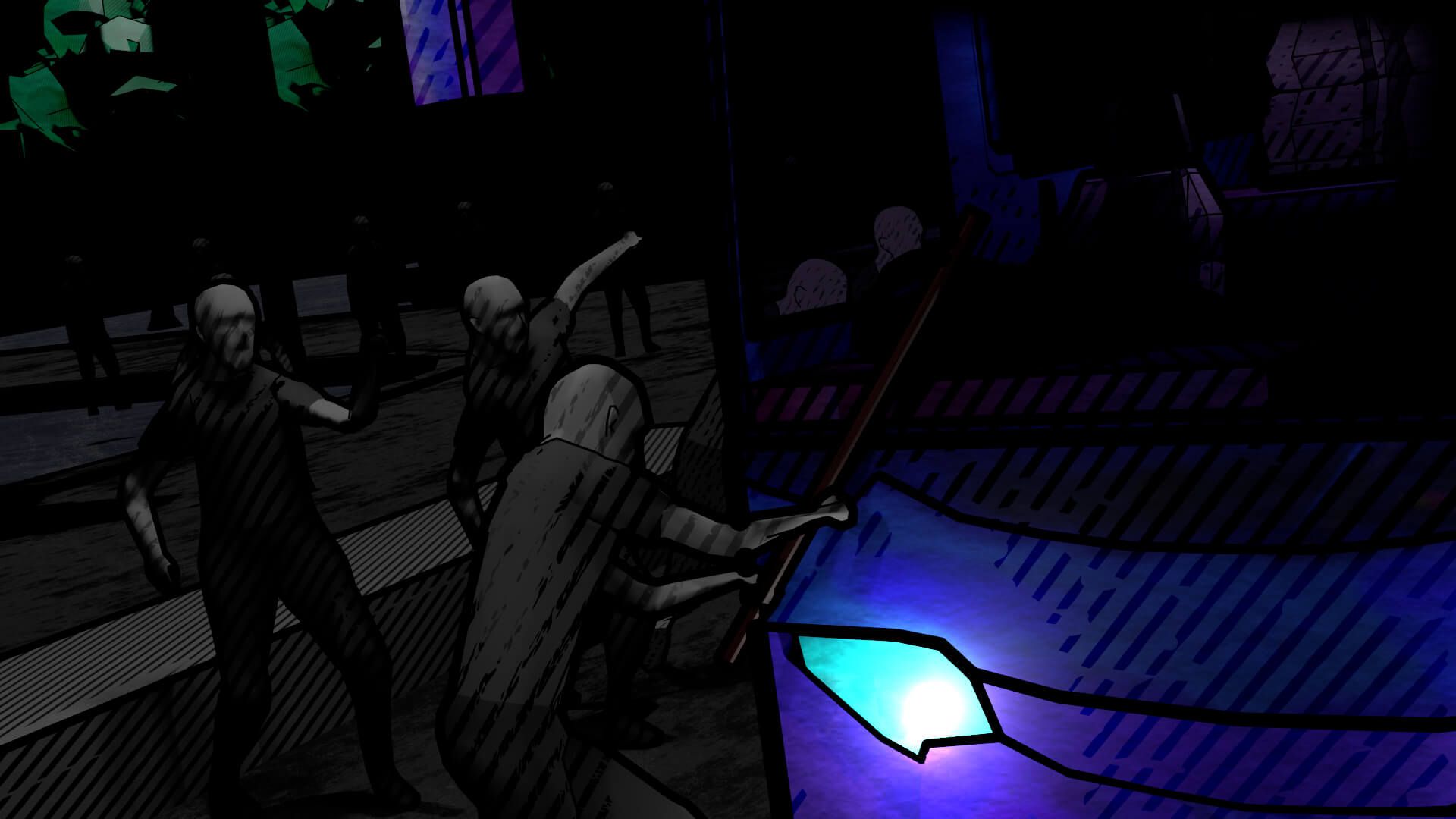


Mr Lee went to look under the bus to see what had happened.
A crowd of workers surrounded the vehicle when they realised a Tamil worker had been run over.
Some of the workers got upset and vented their anger by hitting the bus.
One worker in a chequered shirt, who would later be called the good samaritan by the media, ushered Mr Lee and Madam Wong back onto the bus and blocked the entrance with his body.
The shutting of the bus door enraged the crowd. The workers punched and kicked the vehicle. They also flung shoes, bottles, rubbish bins and even metal drain covers at the bus, shattering its windows and windscreen.
“Suddenly, someone threw a brick into the bus. I tried to dodge, but it hit my left eye and my contact lens fell out. There was a huge gash on my left eyebrow,” said Madam Wong.
Eventually, she took refuge in a space near the driver’s seat, while Mr Lee hid under a rubbish bin that had been flung into the bus.
Two workers managed to climb into the bus through a broken window.
One of the workers assaulted Madam Wong repeatedly on the head with a stick-like object, demanding to know where the bus driver was.
Unable to find Mr Lee, the workers left the bus.
All this was taking place while the police were arriving on the scene and trying to make sense of what was happening.
The police had received the first 999 call at 9.23pm, two minutes after the accident.
The Singapore Police Force’s (SPF) combined operations room informed the Rochor Neighbourhood Police Centre (NPC) and told the Singapore Civil Defence Force (SCDF) an ambulance was needed.
Two Traffic Police officers were sent to manage traffic disruptions.
The officers did not know what they were getting into, as the 999 call did not mention any concerns about violence.
From the COI report, it appeared that the first indication to the authorities that it was more than just a traffic accident came from Certis officers on duty near the site.
One of them saw hundreds of foreign workers surrounding the bus. He radioed Certis teams nearby for help with crowd control.
He also called the Kampong Java NPC, and the team leader there, Assistant Superintendent of Police (ASP) Jonathan Tang, volunteered to go to Little India.
ASP Tang, who was injured in the riot, played a critical role in responding to the situation.
He and his partner rushed to Little India after they received the alert.
HOW IT ESCALATED

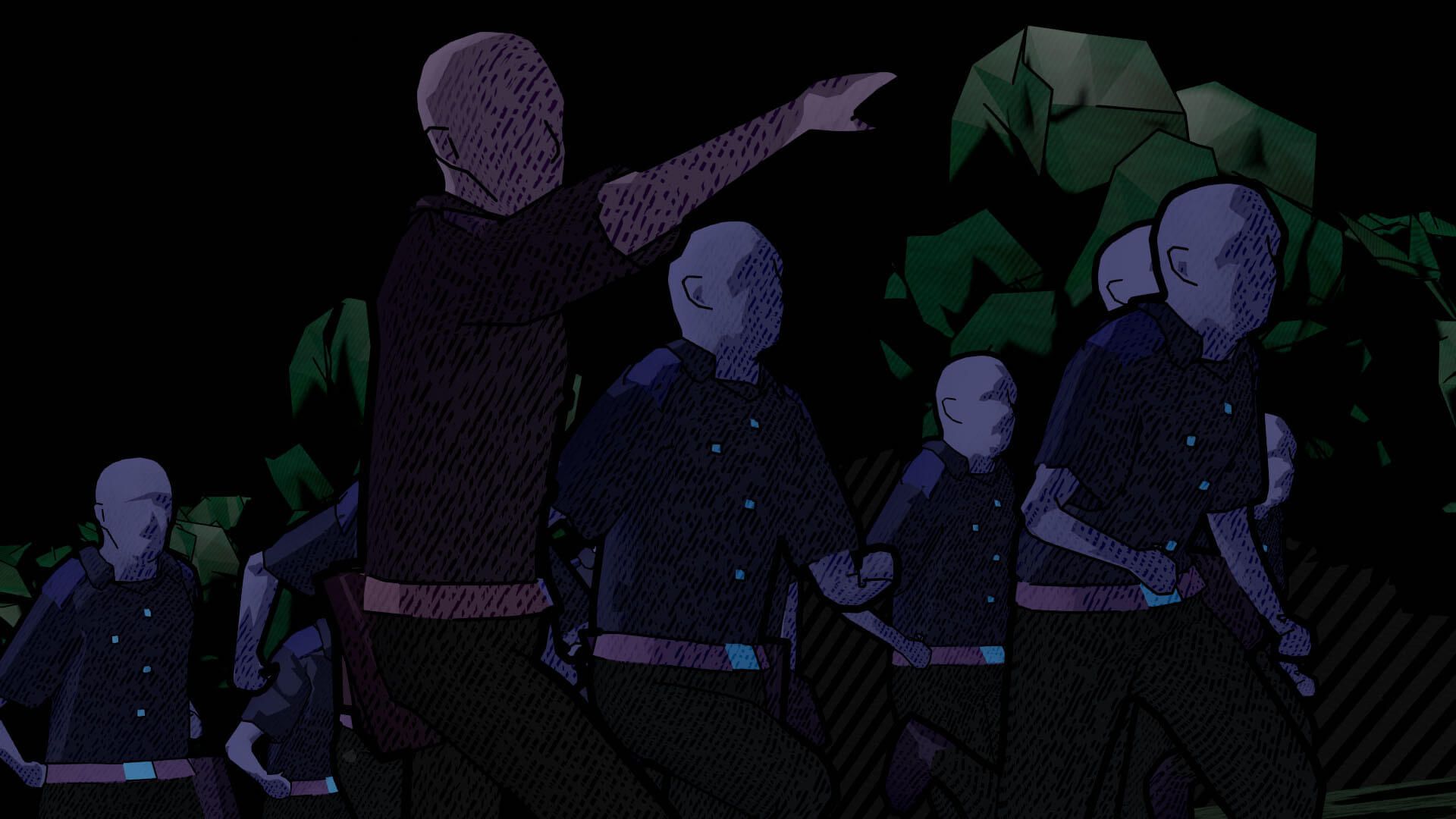

At 9.39pm, an SCDF Red Rhino arrived. Its officers initially did not see the body, but they noticed Madam Wong in the bus. Two officers tried to speak to her.
About a minute later, ASP Tang arrived at the scene. He told police and Certis officers to form a human barrier around the bus to create space for the SCDF officers to pull Mr Sakthivel’s body out. All this time, objects were being hurled at the bus, hitting the officers.
While the SCDF officers were focused on rescuing Madam Wong, more police officers, some equipped with shields and helmets, arrived. ASP Tang directed them towards the bus to shield the SCDF officers, Mr Lee and Madam Wong as they emerged from the vehicle.
Mr Lee and Madam Wong got off the bus at 10.08pm. SCDF officers formed a protective circle around them, while police officers carrying shields formed a semicircle around the SCDF officers and pushed their way past the crowd.
When the mob saw Mr Lee and Madam Wong being protected, everything changed. The projectiles, previously aimed at the bus, were now being thrown at the party protecting the duo.
Between 10.20pm and 10.40pm, before the arrival of the Special Operations Command (SOC), or riot police, the protesters flipped over six vehicles and burned four of them.
Most of the destruction happened between 10.15pm and 10.45pm before the SOC team got to the site.
During this period, the riot centred around the bus accident site in Race Course Road near the shared junction with Tekka Lane and Kerbau Road.
It later spread across the length of Race Course Road, between the junctions of Bukit Timah Road and Hampshire Road.
Northumberland Road would also be affected.
It was Singapore’s worst major public order incident since the racial riots in the 1960s.
The Little India riot left 62 people injured and caused more than $530,000 in damage. Emergency vehicles, including police cars and ambulances, were flipped over and burned.
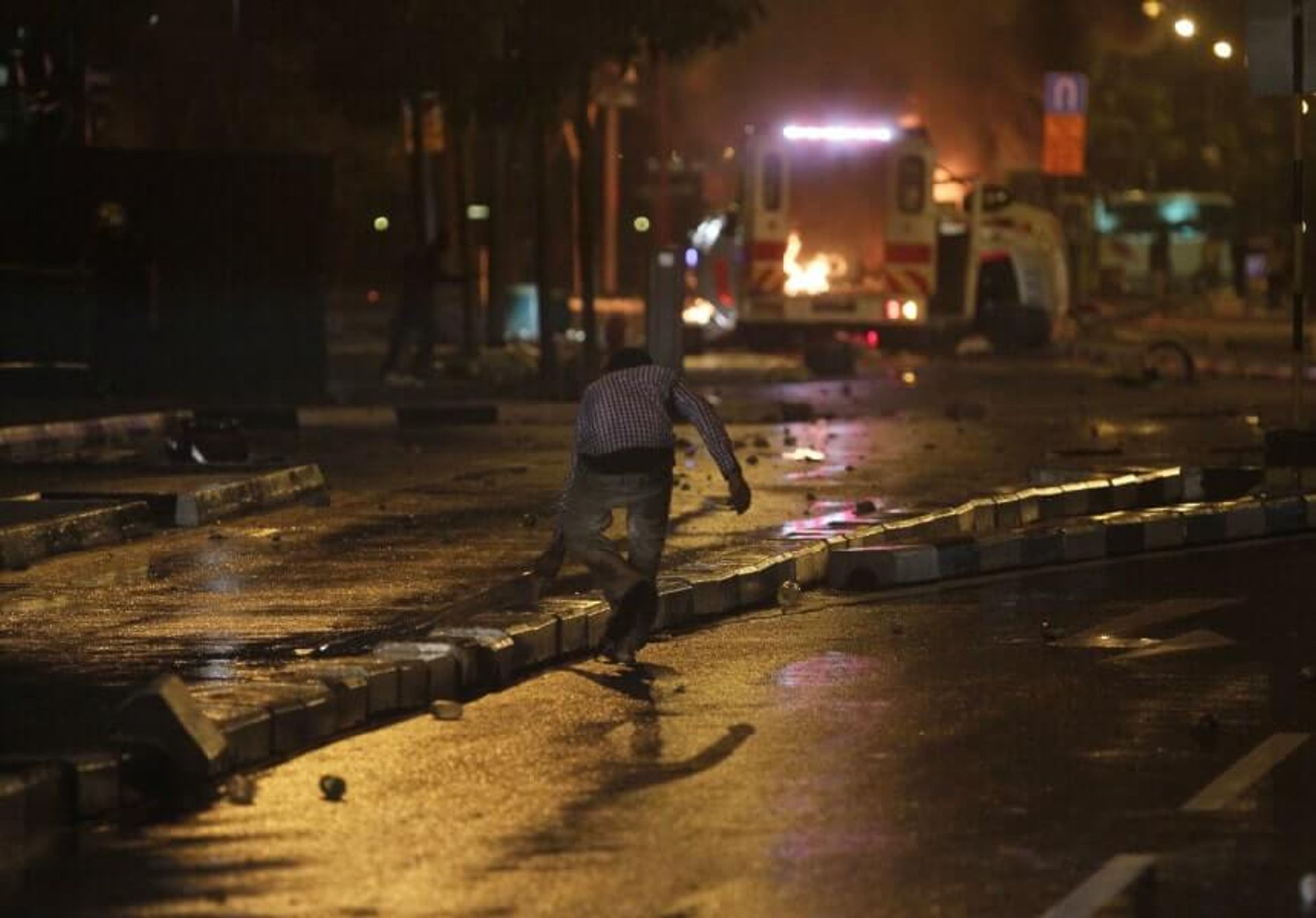
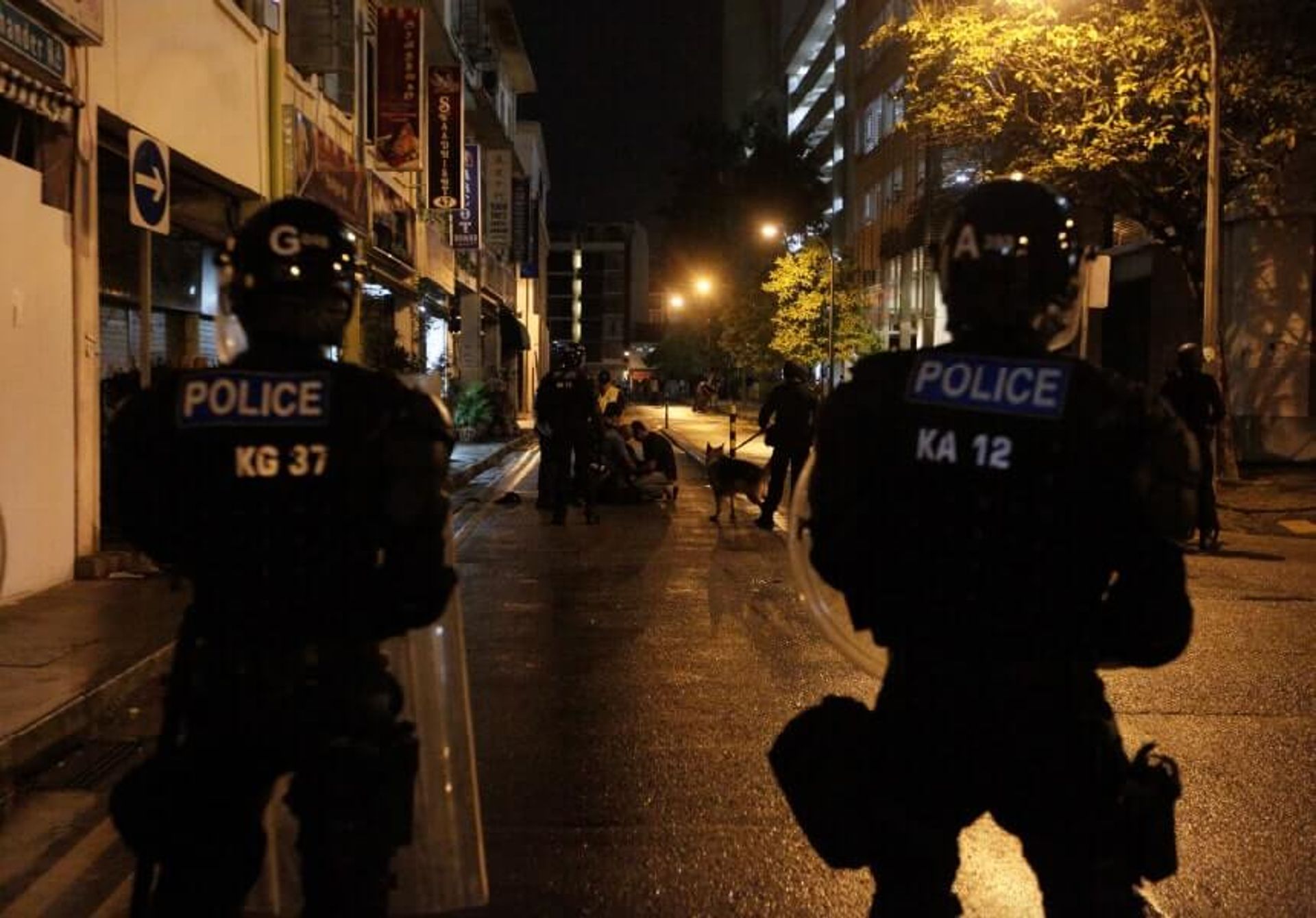
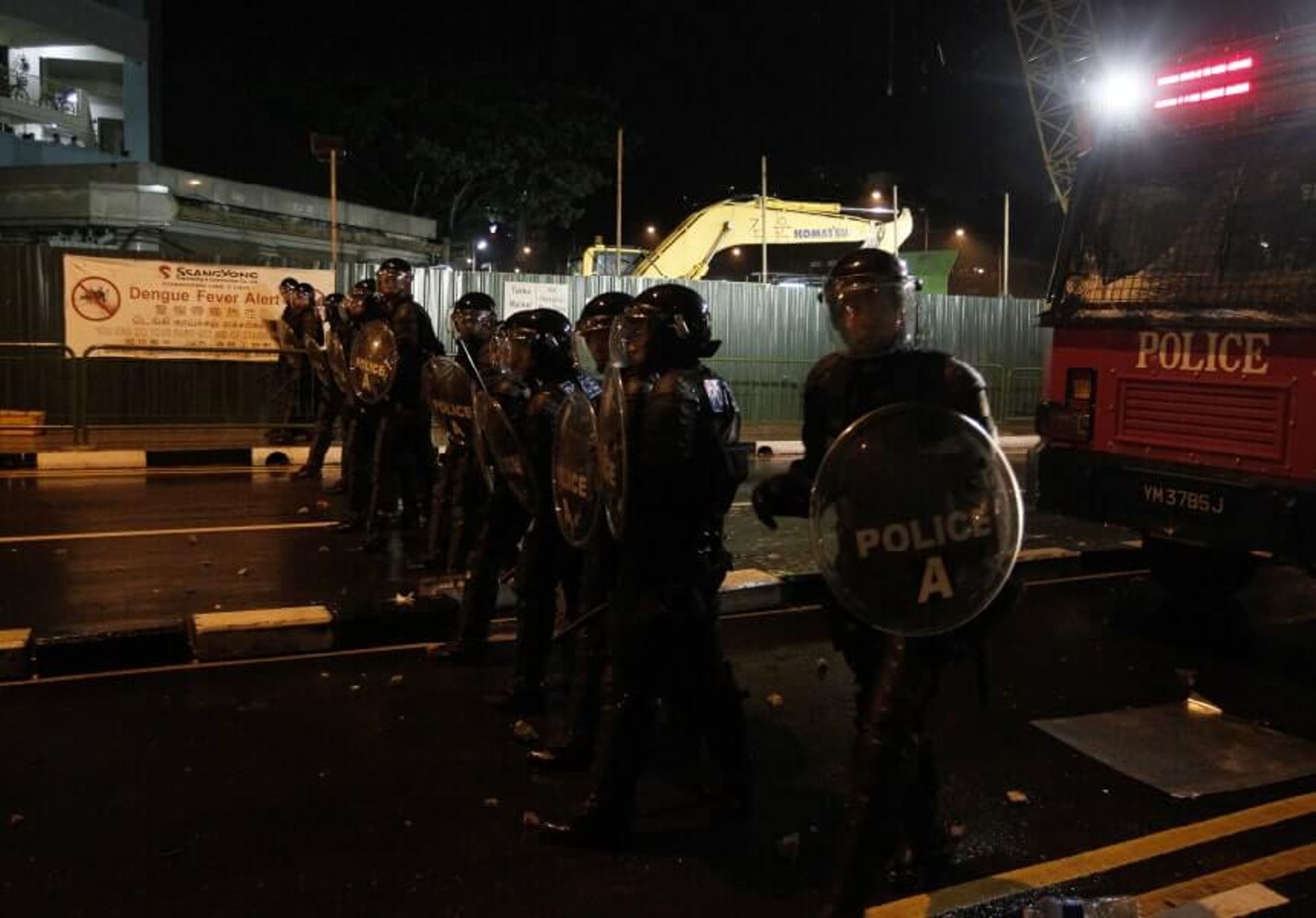
Senior Assistant Commissioner of Police Arthur Law, who was deputy commander of Central Division when he was at the scene, said that night was “surreal”.
He said there were some hundreds of workers gathered at the Hampshire Road and Race Course Road junction when he arrived. “I saw many workers making a lot of noise, but I couldn't really make out what they were shouting.”
That night, I saw cars being overturned, they were being torched. It was nothing that I had encountered before.
He added that before that night, he had gone for overseas training attachments and had been exposed to tactics to deal with public disorder.
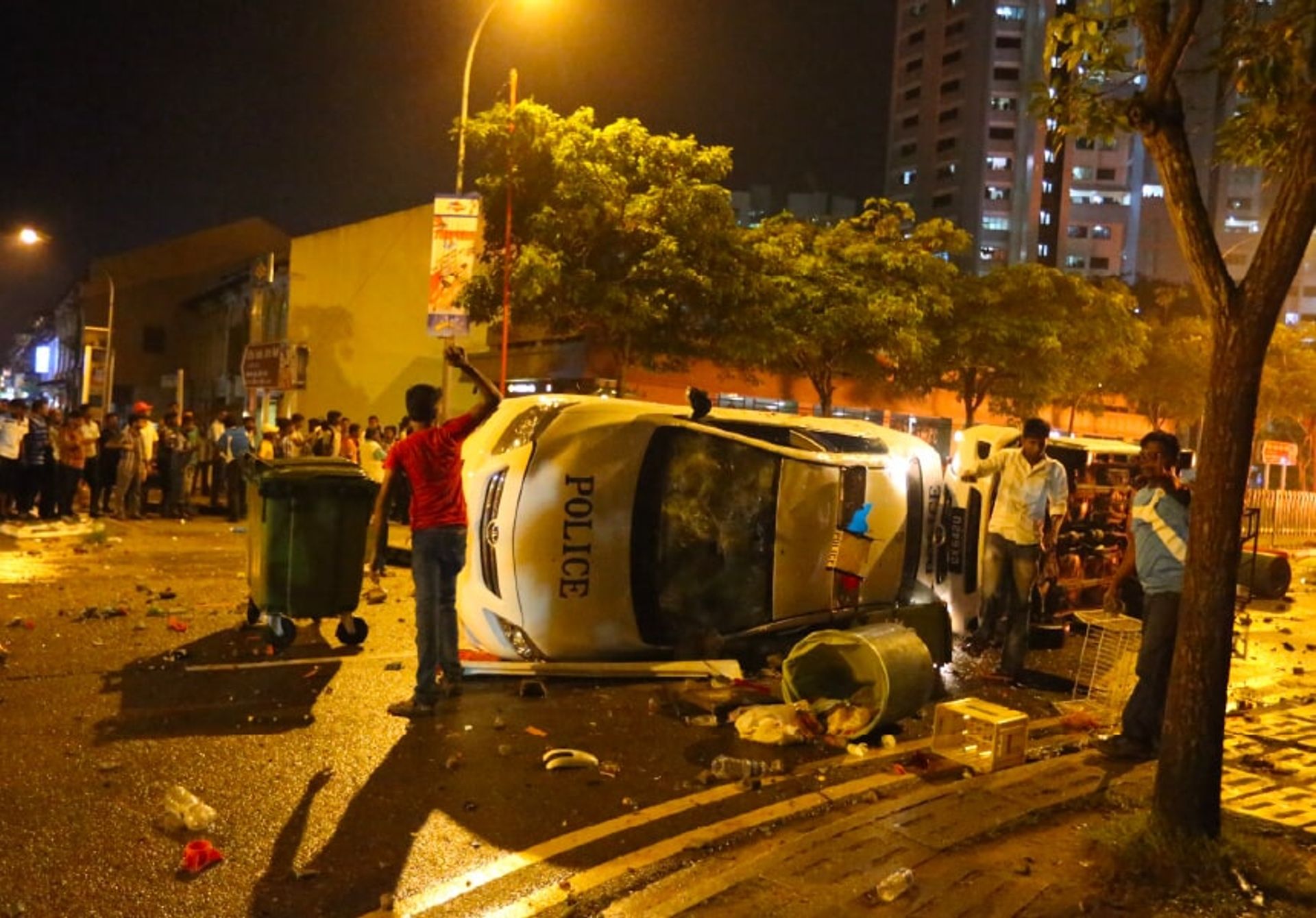
PHOTO: JONATHAN CHOO
At 10.35pm, some SOC troops in their vehicles found their way blocked near Kampong Java Road and made a U-turn to go back down Bukit Timah Road.
Others alighted from their vehicles in Hampshire Road and when the rioters saw these troopers in full riot gear and holding shields, they fled.
The SOC team was finally at the scene in force at about 10.50pm. As the troops marched towards the mob, several rioters surrendered.
Elsewhere, around Little India, police officers continued rounding up troublemakers. The crowd thinned.
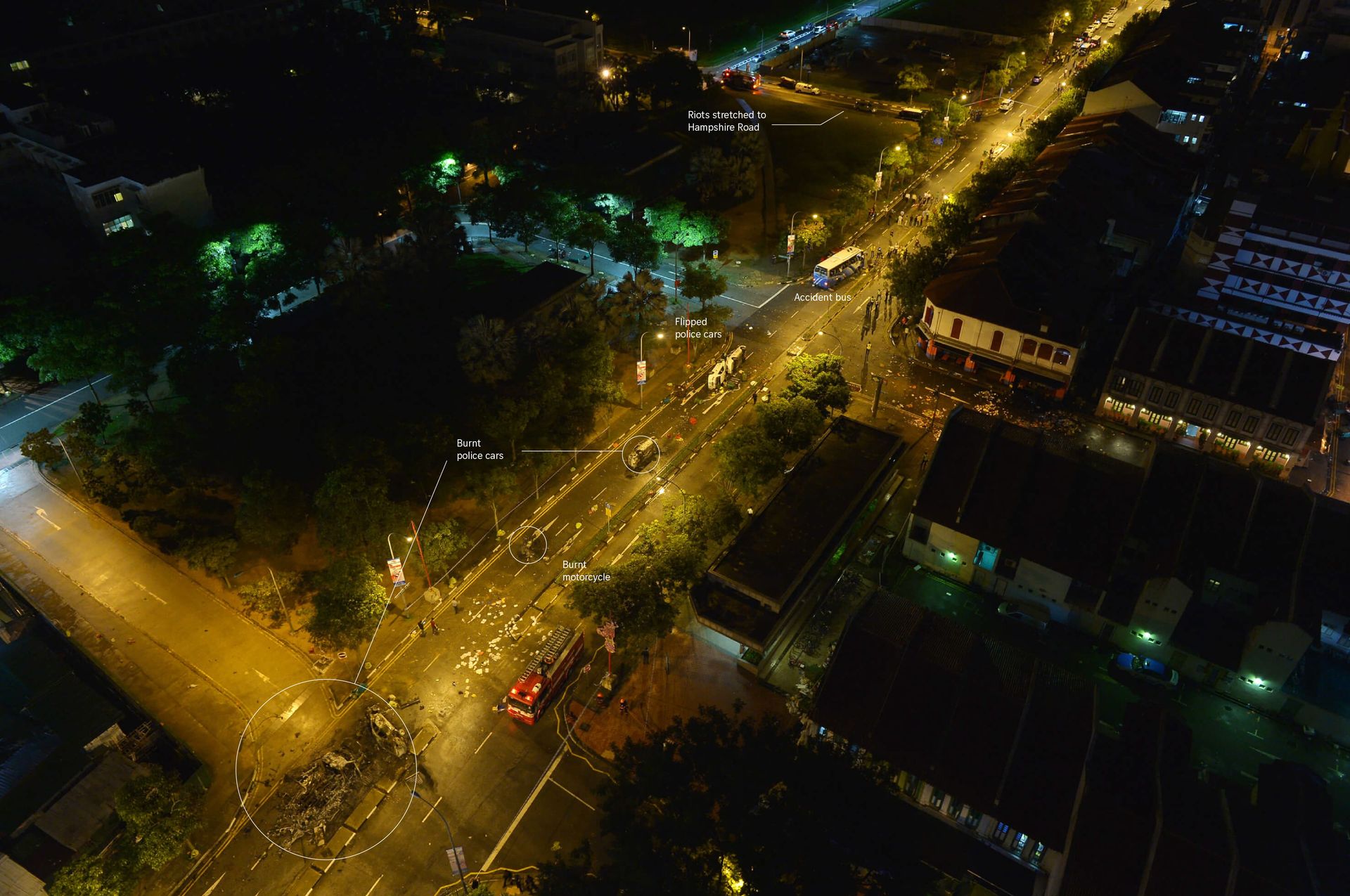
The aftermath of the riot. At least four police patrol cars were overturned by the mob, and an ambulance and two patrol cars were set on fire. ST PHOTO: ALPHONSUS CHERN
At 11.25pm, the riot was finally over and the last pockets of rioters were dispersed.
Incredibly, nobody died during the rioting.No shots were fired, and the police did not use tear gas or water cannons.
There was also no report of looting or arson of private property.
And not one Singaporean was involved in the riot.
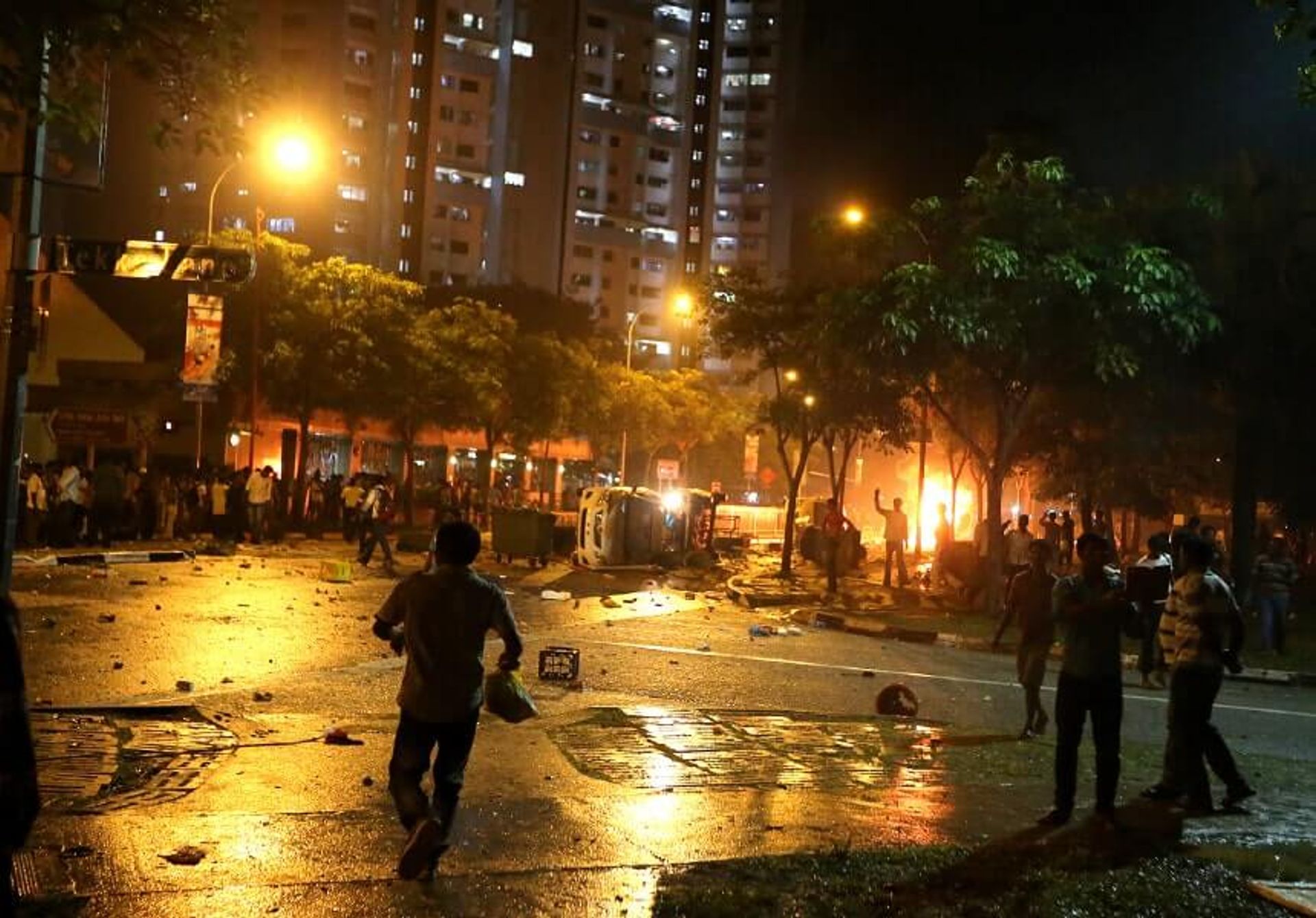
PHOTO: JONATHAN CHOO
A total of 240 police officers and 56 SCDF personnel were deployed that night.
In all, 37 police officers, 12 SCDF personnel, five Certis officers, and eight members of the public were injured.
The rioters damaged 14 police and eight SCDF vehicles, a private ambulance, six private vehicles, and the accident bus.
After cleanup operations, Race Course Road was reopened to traffic at 6.45am the next day.
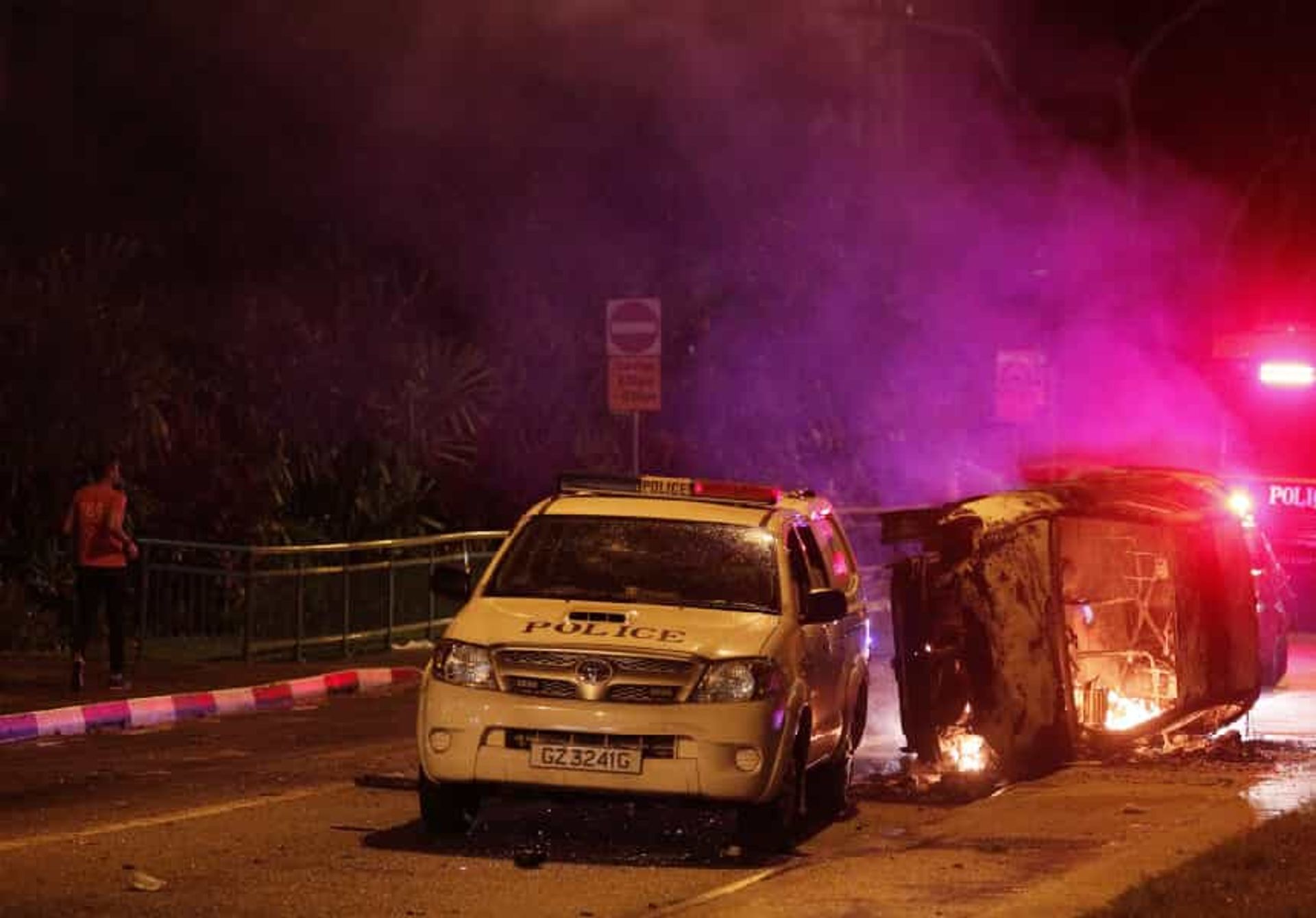
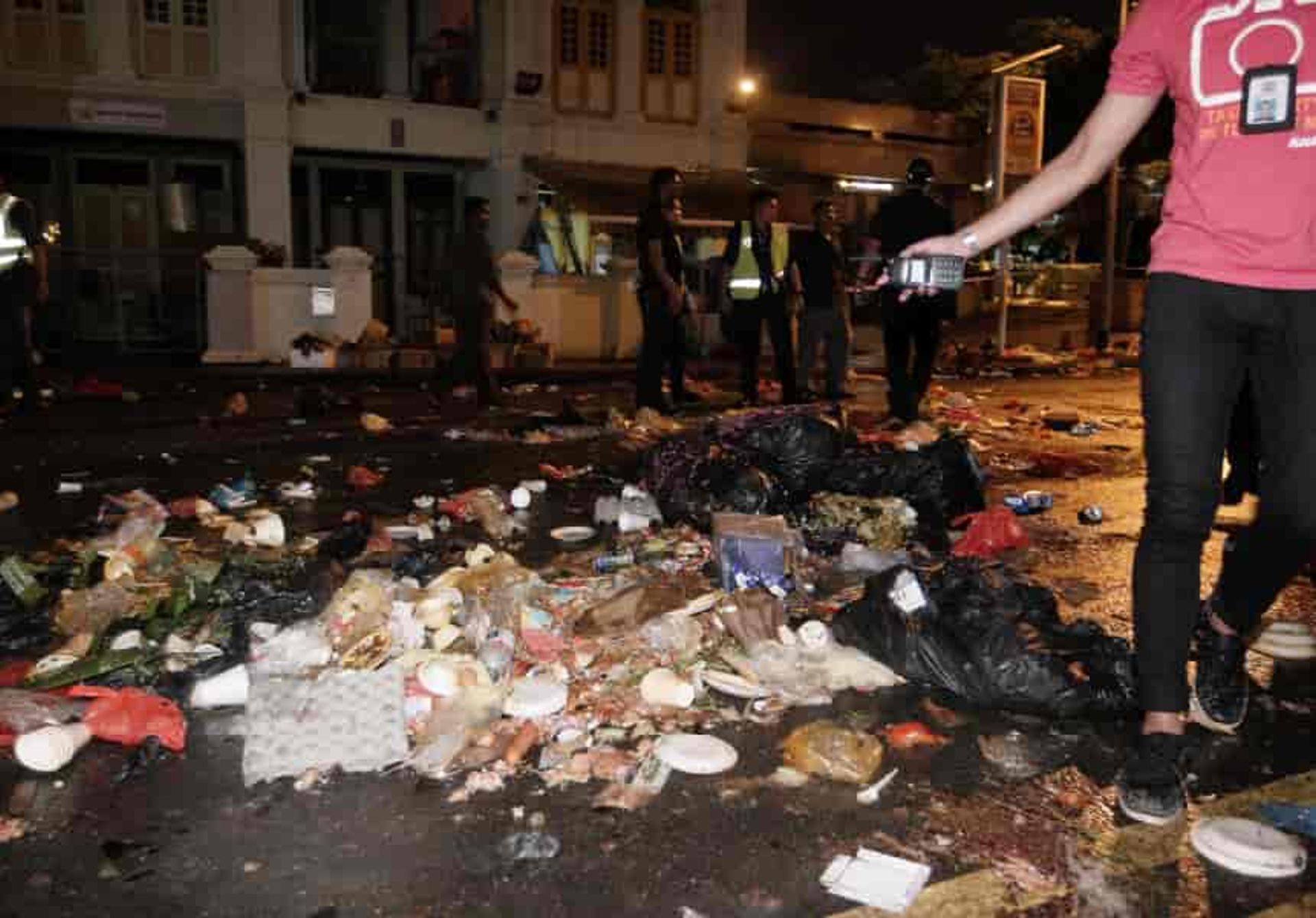
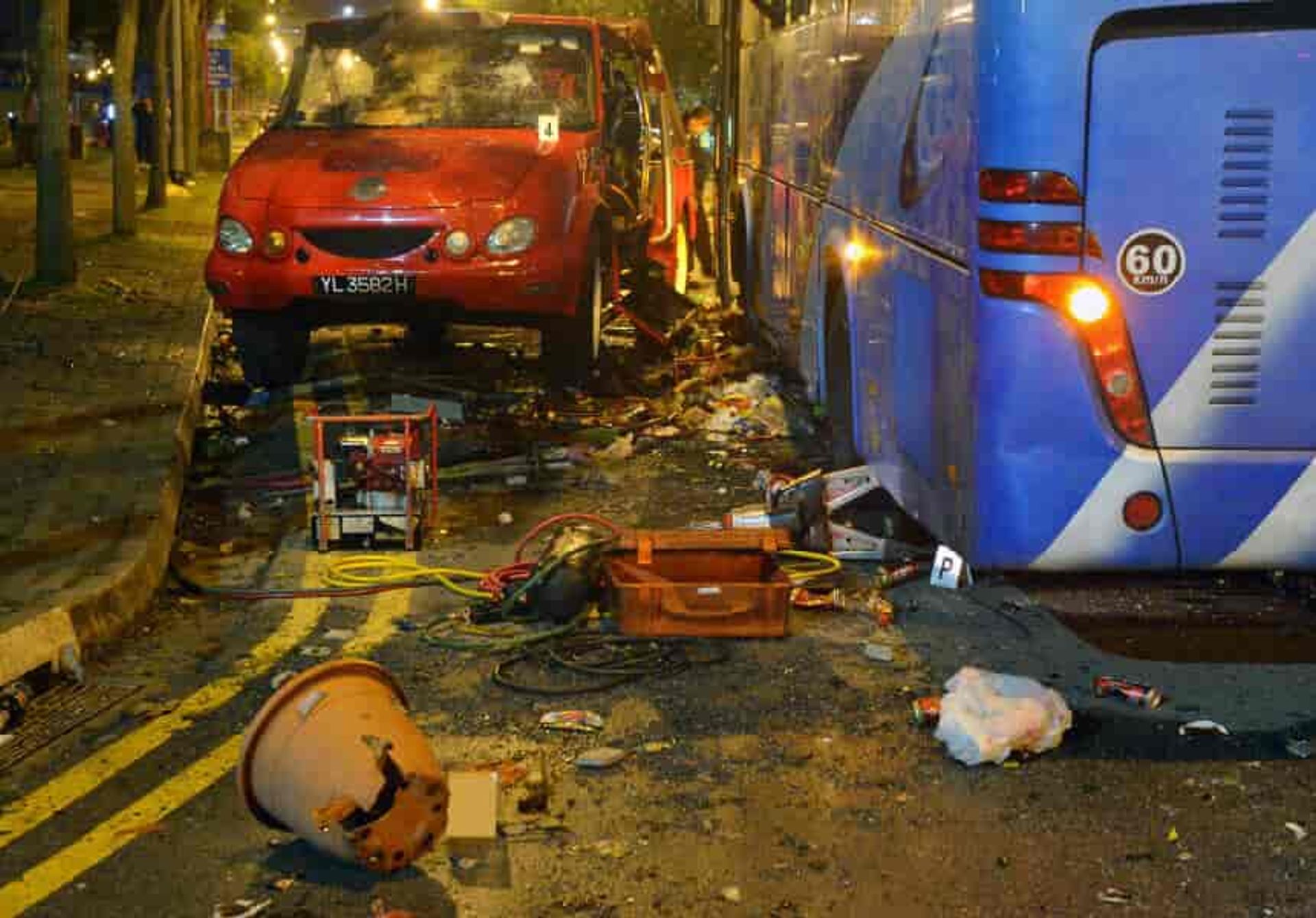
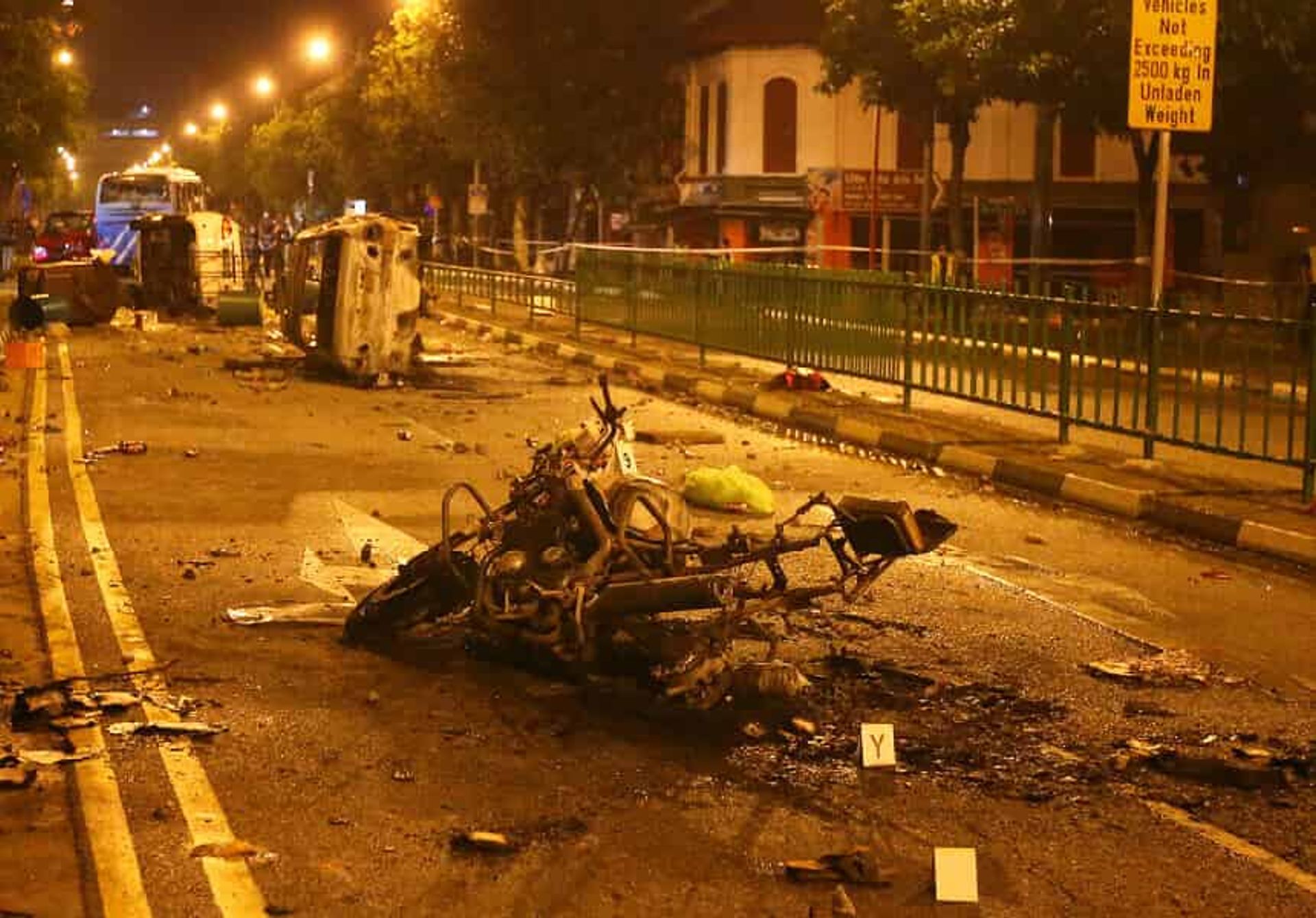
The COI report revealed that rumours and misunderstanding were a huge cause of what sparked the riot.
Mr Lee, who was later cleared of any wrongdoing over the accident, had been blamed by the rioters for Mr Sakthivel’s death.The COI noted that when first responders arrived, the foreign workers had expected officers to arrest and handcuff Mr Lee and Madam Wong.
Instead, they saw officers shielding them. This could have infuriated them further, the COI said.
There were rumours Mr Sakthivel did not die immediately and was left crying for help beneath the bus. Another rumour was that Madam Wong had pushed him off the vehicle.
There were even claims that first responders had kicked and disrespected his body.
All were untrue.
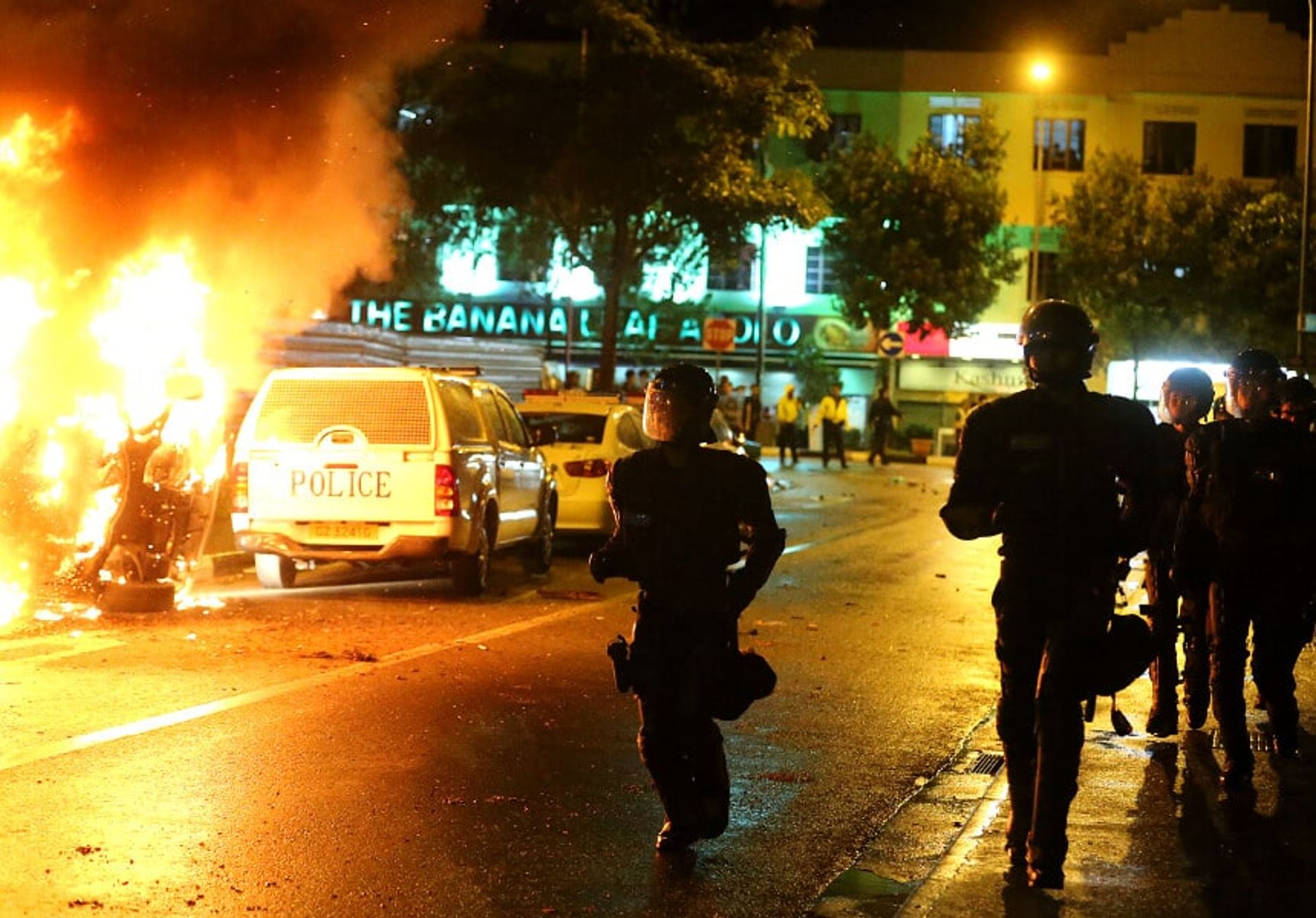
A burning vehicle in Little India during the riot. PHOTO: JONATHAN CHOO
Among the police, there were also communication issues and unnecessary U-turns.
At the beginning of the riot, ASP Tang and SCDF's Lieutenant (Lt) Tiffany Neo were the highest-ranking officers present. But because of the chaos, many officers did not know who was in charge.And it did not help that several high-ranking police officers arrived later in plain clothes.
Many officers found they could not call for reinforcements or notify colleagues of where the rioters were located.
ASP Tang tried contacting one of the ops rooms but found he could not use his radio as it was too noisy. The radio sets were also jammed with too many messages sent over the same frequencies.
He tried calling on the phone but could not get through. The ops room was also unable to contact him on the radio.
Luckily, at 9.45pm, one of the ops rooms called ASP Tang who asked for the riot police to be activated.
The jammed radio sets also resulted in a delay of the SOC’s arrival, as nobody could tell the SOC tactical troops which was the fastest route to the scene.
That caused them to make a U-turn in Bukit Timah Road, resulting in another 15-minute delay due to heavy traffic and multiple traffic junctions along the way.
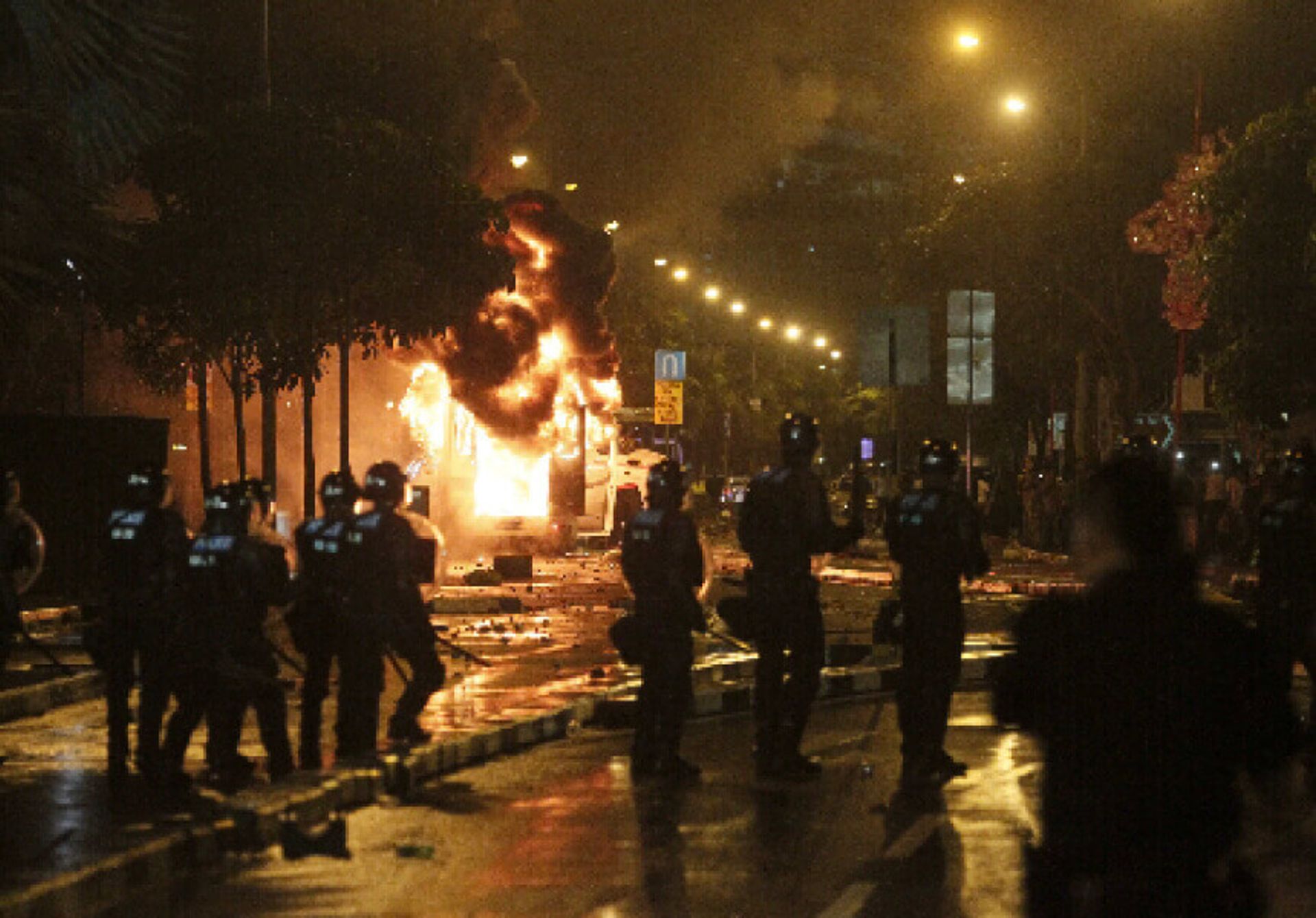
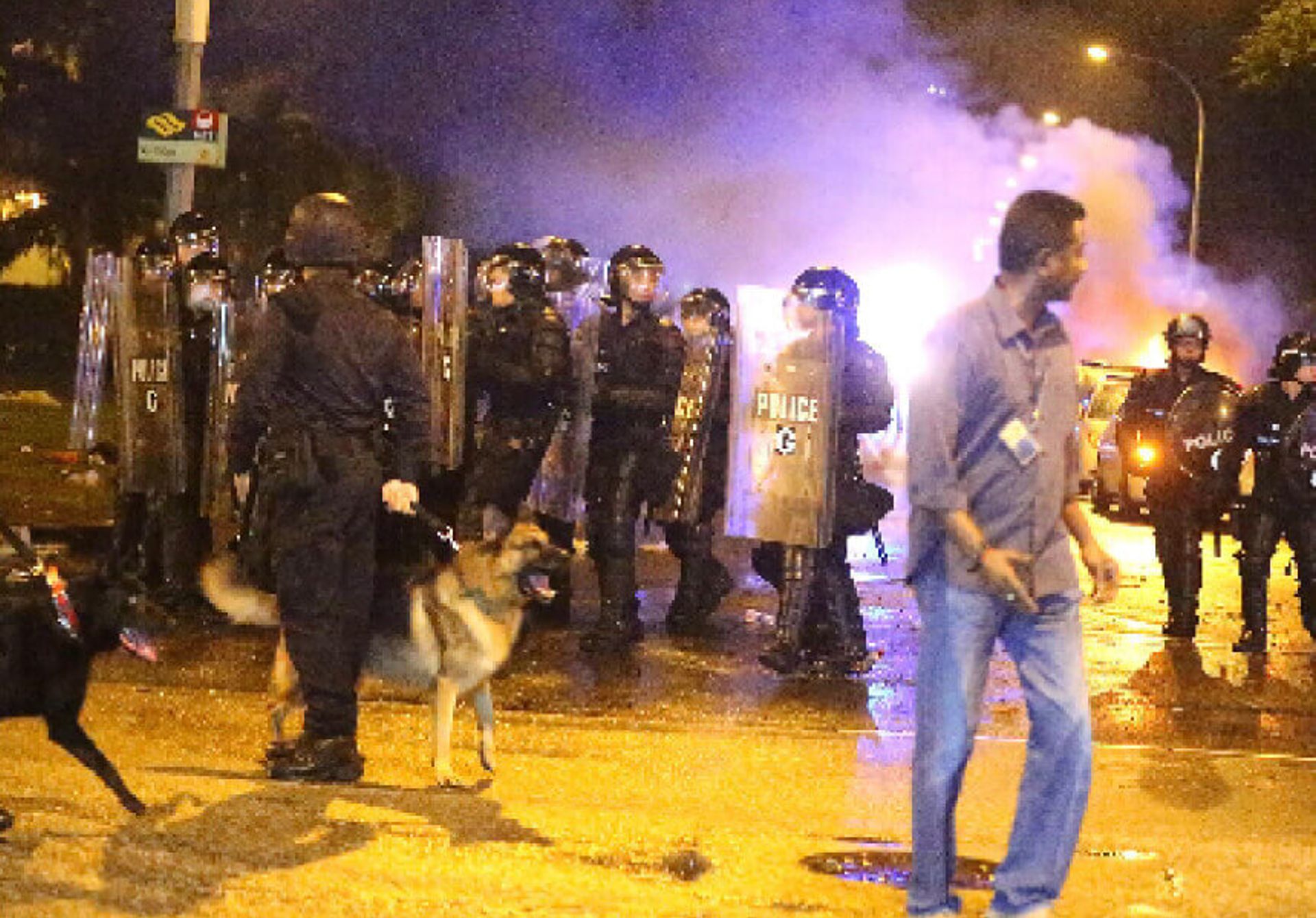
Still, the COI praised the way the police and SCDF officers performed that night, especially Lt Neo who had worked seamlessly with ASP Tang.
Lt Neo showed her mettle under pressure.After extricating Mr Sakthivel’s body, standard protocol stated that in fatal incidents, SCDF should hand the body over to the police.
But seeing police officers struggling to contain the crowd, Lt Neo told her team to cover the body with two blankets as it was in a gruesome state, and to move it elsewhere.
As the SCDF officers were carrying it on a stretcher to an ambulance in front of the bus, police officers tried to protect them. A foreign worker attempted to pull the blankets off the body.
As Lt Neo pushed him off, someone hit her twice in the back. She did not even turn to see who assaulted her.
When they finally reached the ambulance, several injured officers were already there receiving treatment from a paramedic.
The ambulance driver initially did not allow the body to be placed inside his vehicle, as it was against protocol to do so.
But Lt Neo overruled him as they were being pelted by objects. The body was placed inside the ambulance.
The incident might have happened 10 years ago, but its impact still remains.
Though the scar on her left eyebrow is hardly visible now, Madam Wong still has psychological scars. She is now a bus attendant to schoolchildren.In August 2023, she went to Little India for the first time in a decade. It was her first time exiting Little India MRT station in 10 years.
When I take a train or a bus, and it passes Little India, I’ll get nervous. Or when the doors open as the train stops at Little India and people come flooding in, I’ll tense up.
One visible change is the construction of two new bus terminals. Before the riot, workers lined up in an open field dotted with trees.
Mr S. Anand, a resident of Block 668 Chander Road, said the improvements after the riot were clearly visible to residents who are happier.
Previously, there were no proper places for buses to drop off passengers from dormitories, or areas for people to sit or stand. So most just sat in groups at a field near Tekka Lane, said Mr Anand who used to sell briyani rice at a shop near Kerbau Road.
One of the two bus terminals is in Hampshire Road, and the other, Tekka Lane. The bus terminals have fans. The surrounding areas are also paved, providing a better environment for foreign workers waiting for buses.

Construction is also under way to expand the Little India Bus Terminal along Tekka Lane, which is expected to be completed in the fourth quarter of 2024, according to the Land Transport Authority. Bus services now end at 9pm instead of 11pm.
Within Little India itself, there has been a stark increase in surveillance. In 2020, then Senior Parliamentary Secretary for Home Affairs Amrin Amin said the number of police cameras deployed in the district has risen from 34 in 2016 to about 200 in April 2020.
Signs of police surveillance can be seen all around Little India.
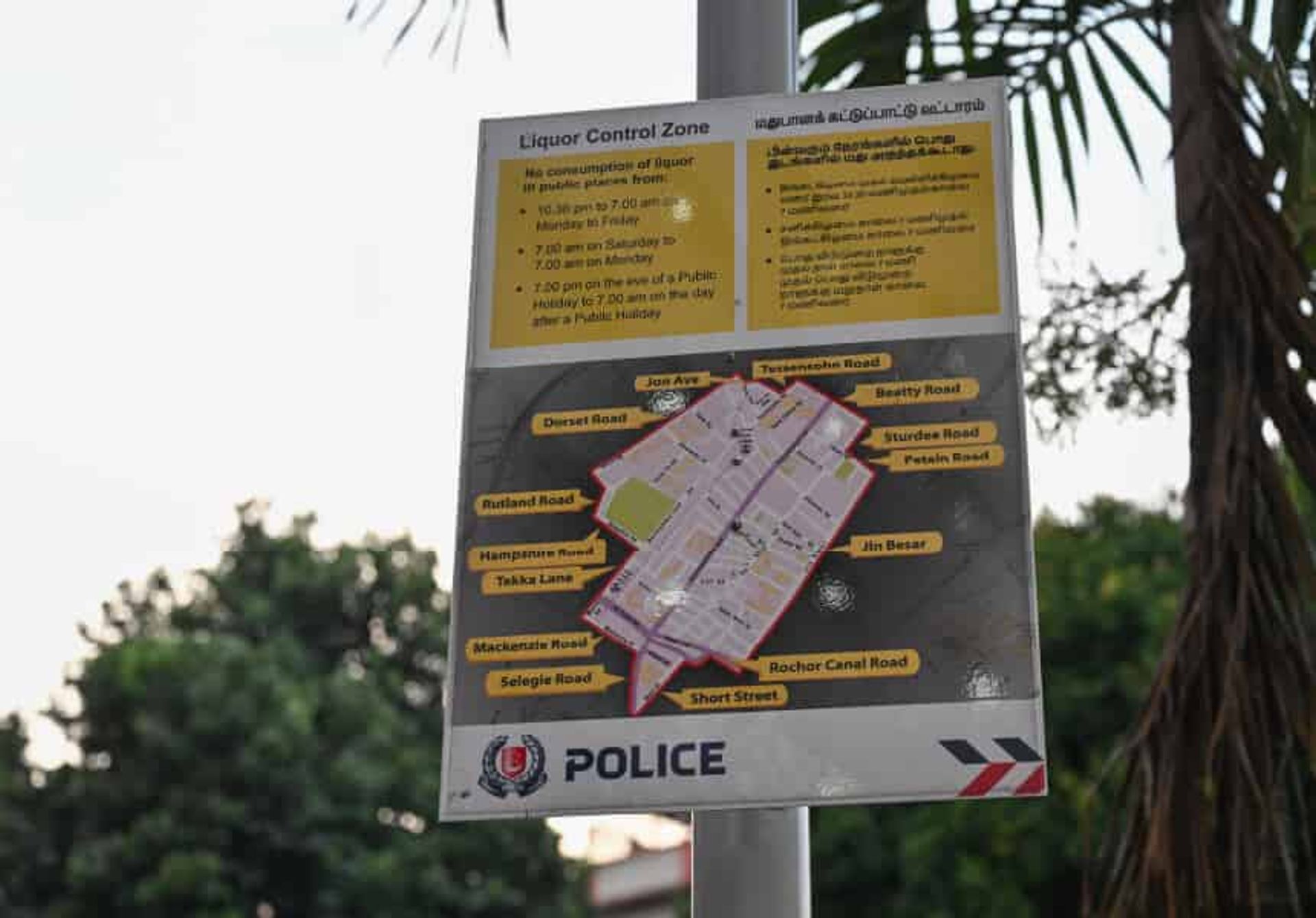
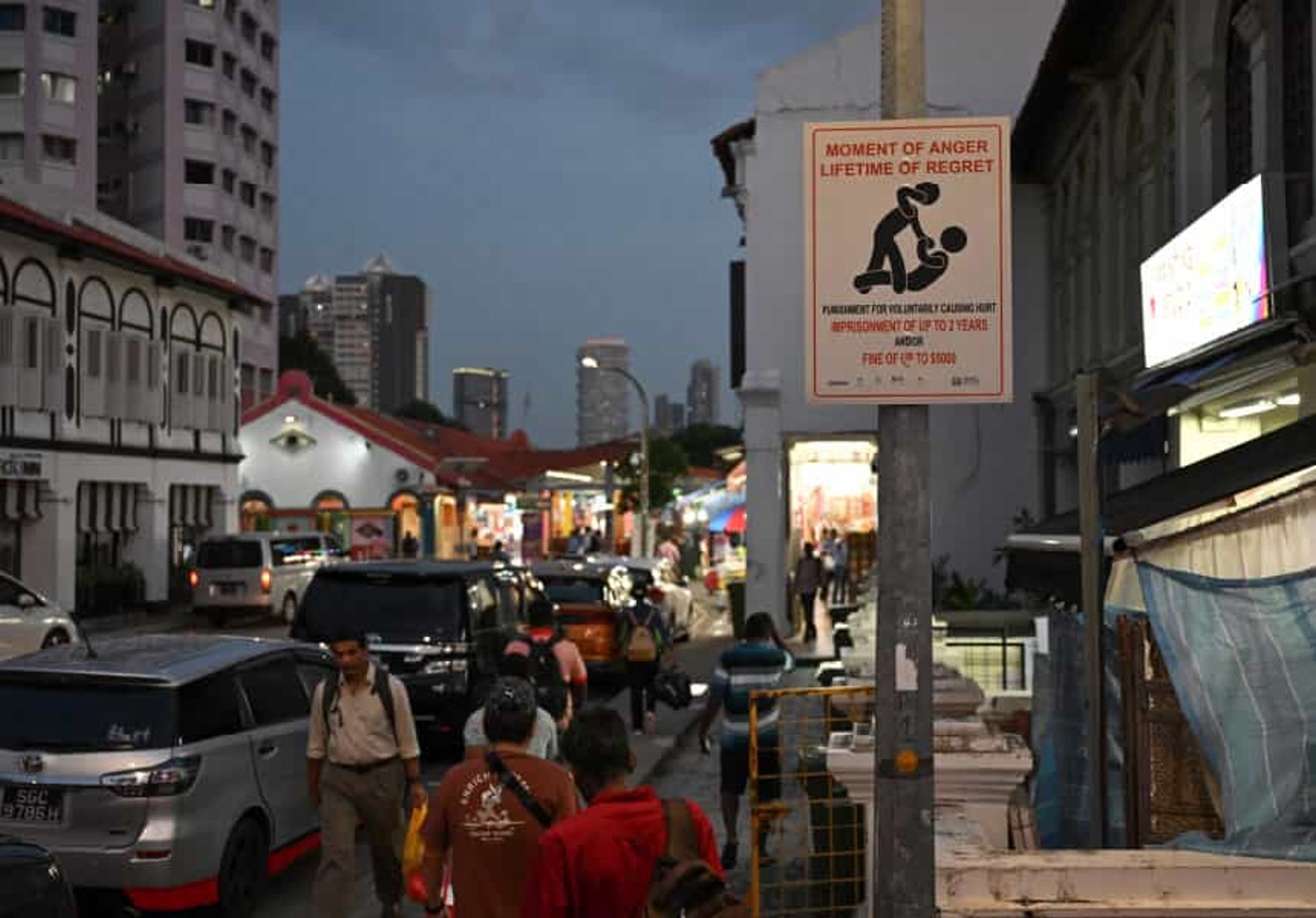
Mr Subramani Purushothaman, 57, who has been living in Block 661 Buffalo Road for 20 years, said he has noticed the increased police presence in the area. For example, he has seen auxiliary police confronting migrant workers drinking in the open – their photos were taken and the drinks were emptied into rubbish bins. The workers were also told to leave.
In 2015, a year after the inquiry, a designated Liquor Control Zone was implemented, prohibiting the consumption of alcohol from 7am on Saturday to 7am on Monday.
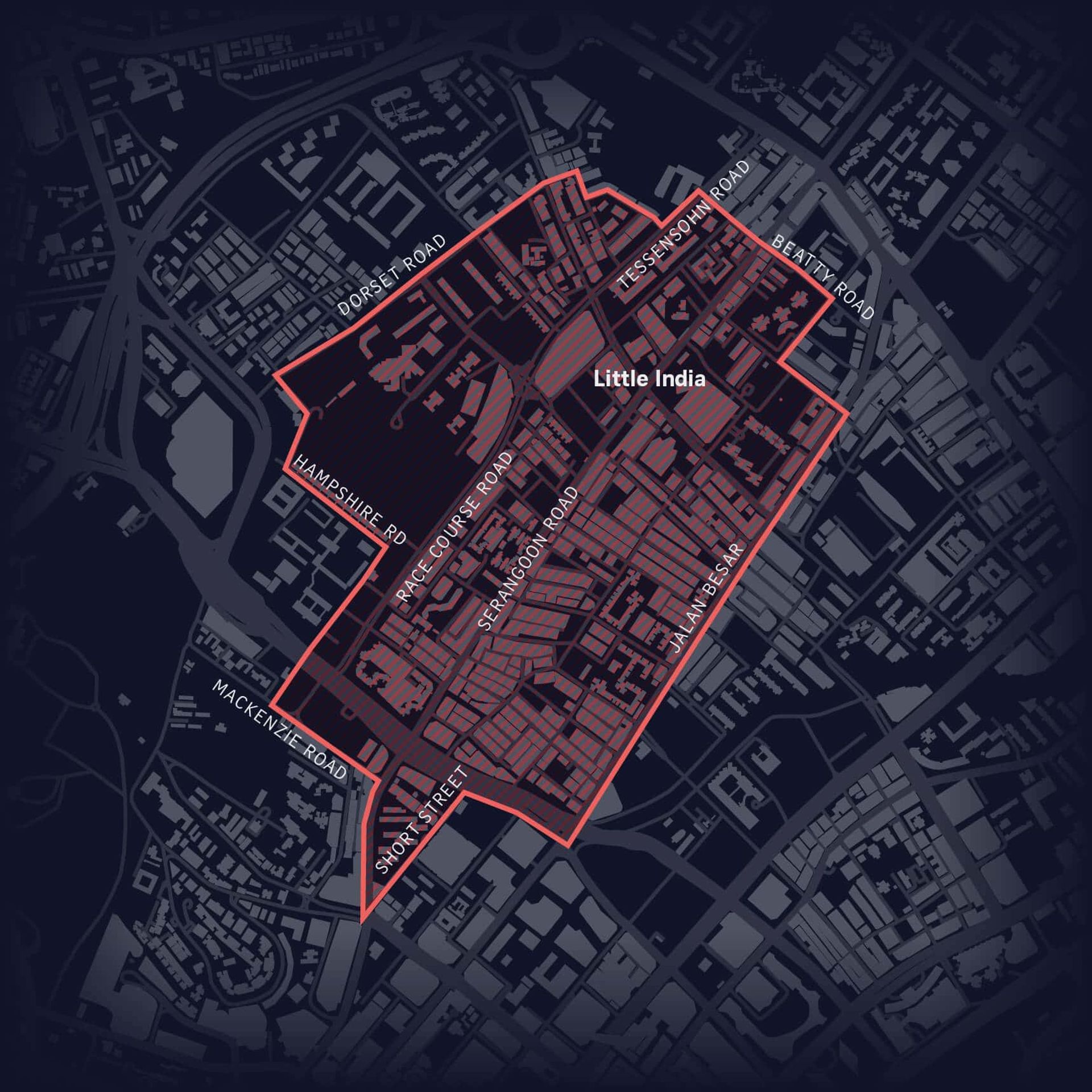
The ban under the Liquor Control (Supply and Consumption) Act also applies from 7pm on the eve of a public holiday to 7am on the day after the public holiday. On weekdays, consumption of alcohol is prohibited from 10.30pm to 7am.
Shops in Little India and Geylang are not allowed to sell takeaway alcohol from 7pm on weekends, on the eve of public holidays, and on public holidays.
This move came after a temporary ban on the sale and consumption of alcohol in Little India on the weekend of Dec 14 and 15 immediately after the riot. The ban was then extended for six months until June 24, 2014, and has been in effect since.
“Overnight, Little India became quiet and clean,” said Mr Anand.
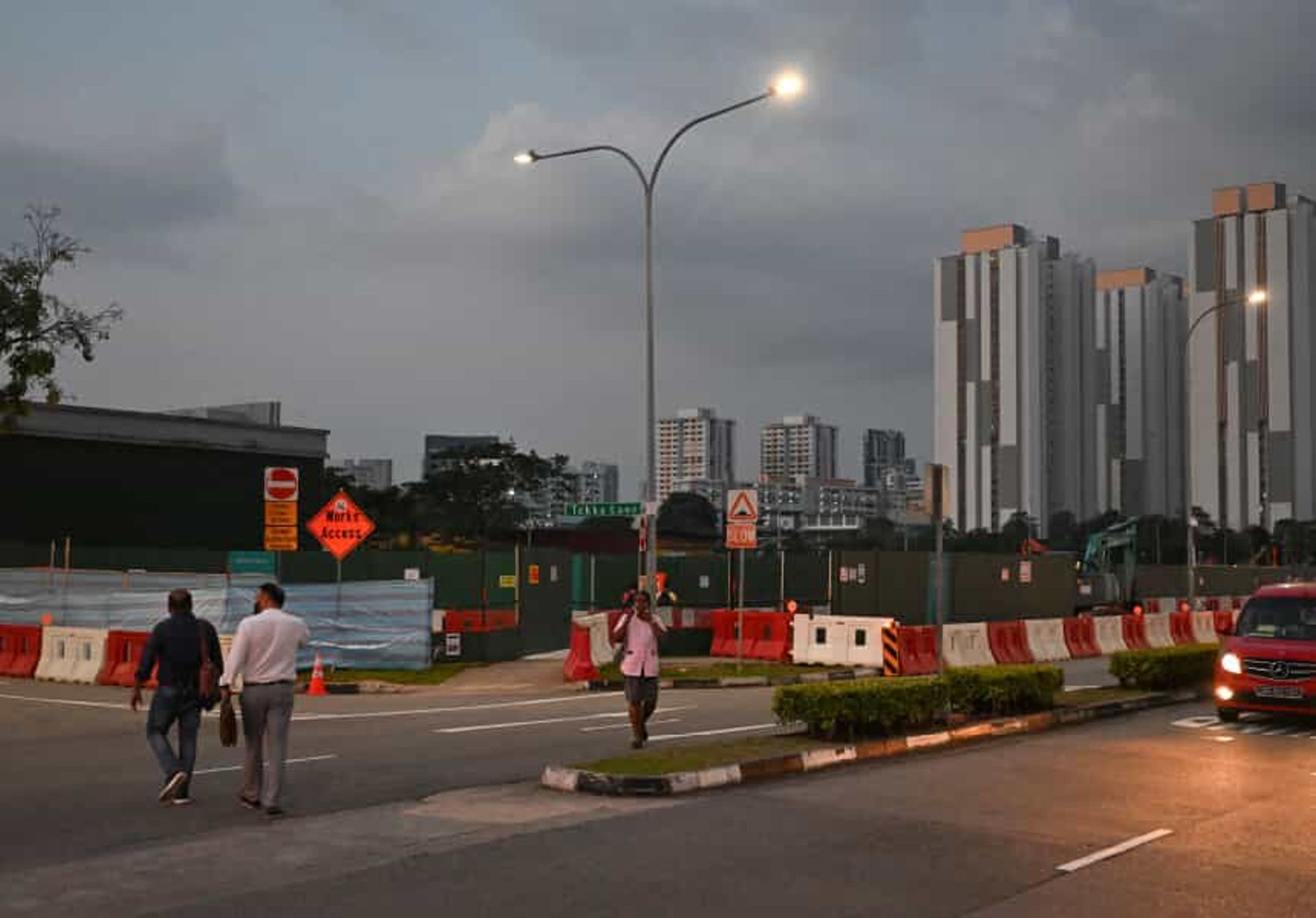
- Joined
- Jul 25, 2008
- Messages
- 13,542
- Points
- 113
Little India rioters chanted ‘Kill the woman, burn the bus’: Certis officer
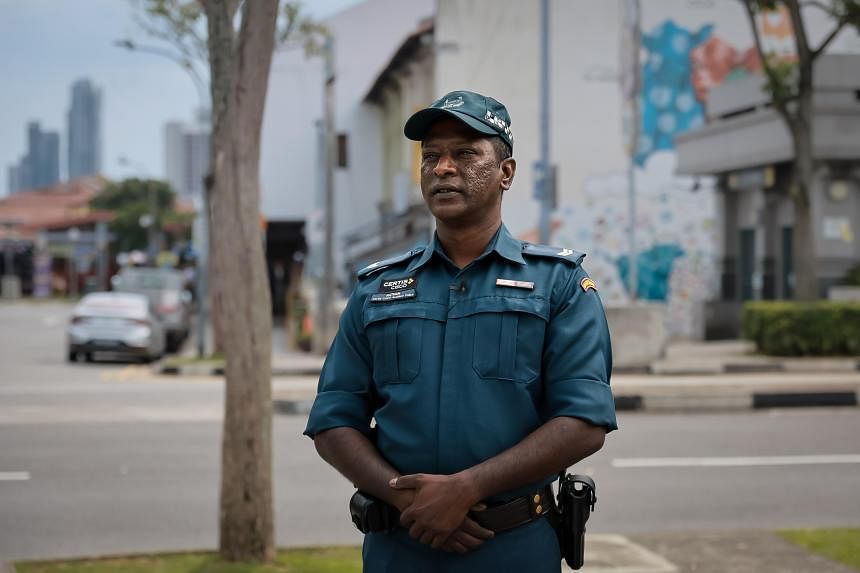
Certis officer Nathan Chandra Sekaran was on duty at Little India on Dec 8, 2013, when he saw a parked bus surrounded by a rowdy crowd. ST PHOTO: GAVIN FOO

David Sun
Crime Correspondent
Dec 3, 2023
SINGAPORE - A rock the size of a fist slammed into his head as shattered glass rained down on him during the riot in Little India on Dec 8, 2013.
Certis officer Nathan Chandra Sekaran, then 34, was surrounded by hundreds of rioters, who were so close he could smell the stench of alcohol on their breaths.
“They were chanting in Tamil, ‘Kill the woman, burn the bus,’” he said. “They told me to leave and said they didn’t want to have a problem with me because I was Indian. But how could I? I told them it was my duty to protect that woman, so I could not go.”
That night, several hundred migrant workers had surrounded a private bus that had run over and killed Mr Sakthivel Kumaravelu, 33, a construction worker from Tamil Nadu in India.
The rioters blamed the bus timekeeper, Madam Grace Wong Geck Woon, and the bus driver, Mr Lee Kim Huat, for the man’s death. They wanted to attack the duo as they holed up inside the bus.
The rioters were especially upset with Madam Wong, because of a rumour she had pushed Mr Sakthivel off the vehicle.
As timekeeper, she was responsible for the movement of buses transporting foreign workers from Little India to their dormitories in Jalan Papan in Jurong.
Corporal Nathan, now 44 and a Certis officer of more than 13 years, remembered glass shards and debris falling out as he unbuttoned his uniform after the riot.
Earlier that day, the Malaysian had reported for his shift at Little India. It was a volunteer shift on top of his usual duties at hospitals.
He did this every weekend, to educate foreign workers about Singapore’s laws while patrolling Little India.
Just before 9.30pm, he was in Race Course Road near the junction of Hampshire Road when he and his colleagues saw an oddly parked bus in the middle of the road.
He said a rowdy crowd had surrounded the vehicle, alarming the Certis teams there.
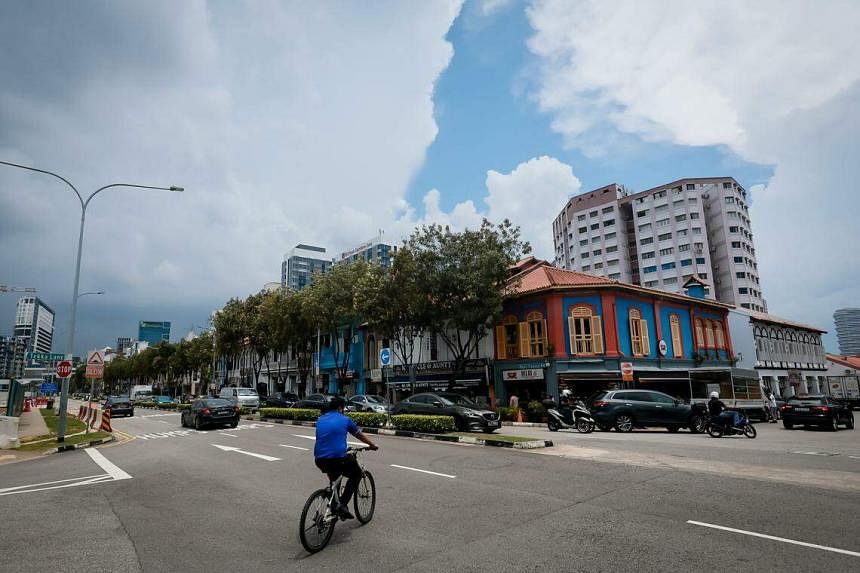
Race Course Road was where the Little India riot happened on Dec 8, 2013. It marked Singapore’s worst major public order incident since the racial riots in the 1960s. ST PHOTO: GAVIN FOO
Cpl Nathan said: “Six of us ran towards the bus and saw a crowd of about 50 people surrounding and throwing glass bottles at it.”
He said they tried speaking to the crowd, in Tamil, and warning them but to no avail.
He said the workers were angry with Madam Wong.
“There were several rumours. Some said she pushed him off the bus, some said he had initially been alive and stuck under the bus,” said Cpl Nathan.
The Committee of Inquiry (COI) convened to probe the riot found that the rumours were untrue.
SPH Brightcove Video
Cpl Nathan did not know there was also a driver hiding with Madam Wong.
All he and his colleagues knew was that they had to protect her. So, the six of them stood in a row in front of the bus entrance to form a human barrier.
But the angry mob swelled, greatly outnumbering them.
Said Cpl Nathan: “About 300 of them surrounded us, throwing rocks, glass bottles and bricks. Even though we were injured and in pain, we refused to leave the woman behind.”
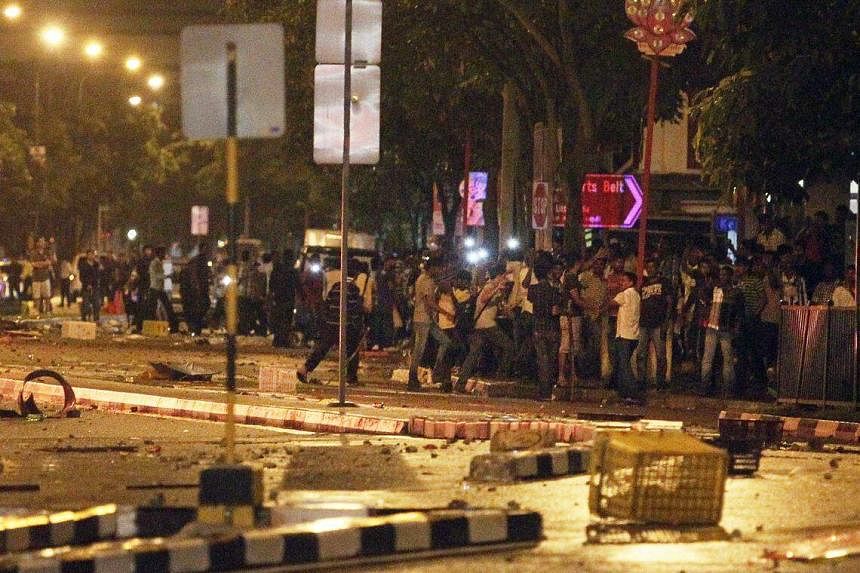
The angry mob greatly outnumbered the officers during the 2013 riot. A total of 25 people were arrested at the scene that night. PHOTO: ST FILE
He added that they chose not to draw their guns to avoid escalating the situation.
Instead, they used only their batons to keep the rioters at bay.
Cpl Nathan said about three migrant workers helped the officers in trying to stop the mob.
For about 20 minutes, the outnumbered group was battered by the rioters, but stood their ground.
Cpl Nathan said: “We could only hope backup would come in time. We did what we thought was right, as there were no clear instructions because the communication channels were down.”
Meanwhile, his superior, Staff Sergeant Mahmood Masdar, then 47, was about 200m away near the junction of Rotan Lane and Chander Road.
Staff Sgt Mahmood had heard about an incident taking place in Race Course Road, and was told by the police to approach any police officers there.
He said he saw several uniformed police officers taking instructions from a woman, who was in civilian clothes and had a police pass around her neck.
When he approached her, she ordered him to stay away from the danger zone, which was where the bus was.
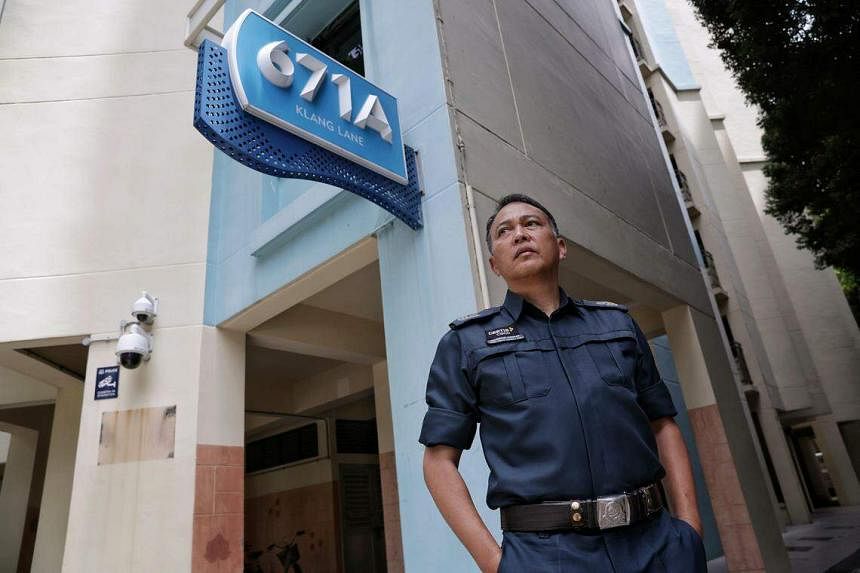
Staff Sergeant Mahmood Masdar at his initial location at 671A Klang Lane when the riot broke out 10 years ago. ST PHOTO: KEVIN LIM
Instead, they were to stay put at the junction of Race Course Road and Hampshire Road.
Staff Sgt Mahmood could only watch helplessly as his men were attacked.
He said: “I asked the policewoman if they could spare some protective gear for my men, but she said they did not have enough for their own officers.”
Staff Sgt Mahmood saw rioters flip over a police car barely 10m away, and burn it.
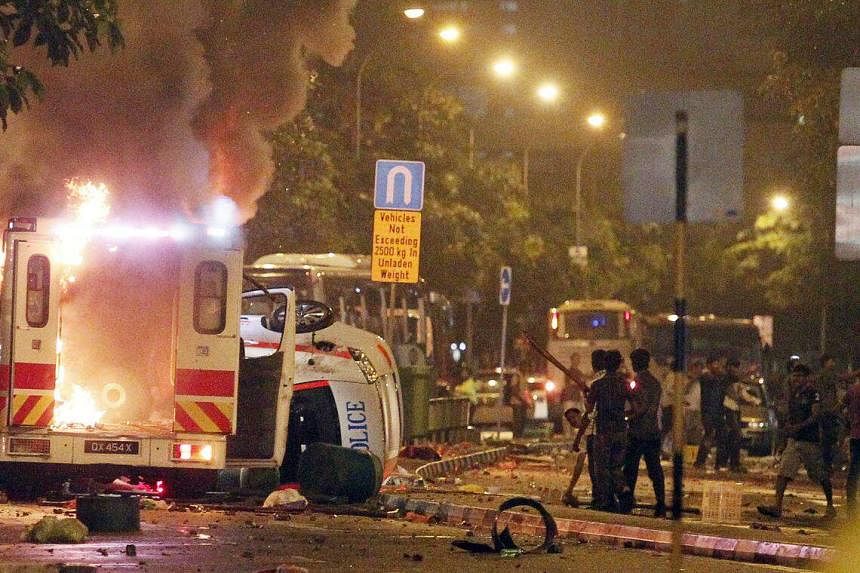
An ambulance was set on fire during the 2013 riot in Race Course Road. A total of 30 vehicles were damaged. PHOTO: ST FILE
He added: “I said ‘Madam, they are going to flip the car, we should stop them’. But she said our orders were to stay put.”
He was then ordered to go to Kampong Java Road to manage traffic, letting only police and Singapore Civil Defence Force (SCDF) vehicles into Little India.
SCDF personnel who responded to the incident were crucial in the extrication of Mr Sakthivel’s body, and in the rescue of Mr Lee and Madam Wong.
Senior Assistant Commissioner of Police (SAC) Arthur Law, then deputy commander of Central Division, arrived at the junction of Race Course Road and Bukit Timah Road.
Now commander of the Special Operations Command (SOC), he said of the scene that night: “It was surreal. I’ve gone through overseas exchanges and training attachments, and had much exposure to public order tactics. But that night, I saw vehicles being overturned and torched. That was nothing I had encountered before.”
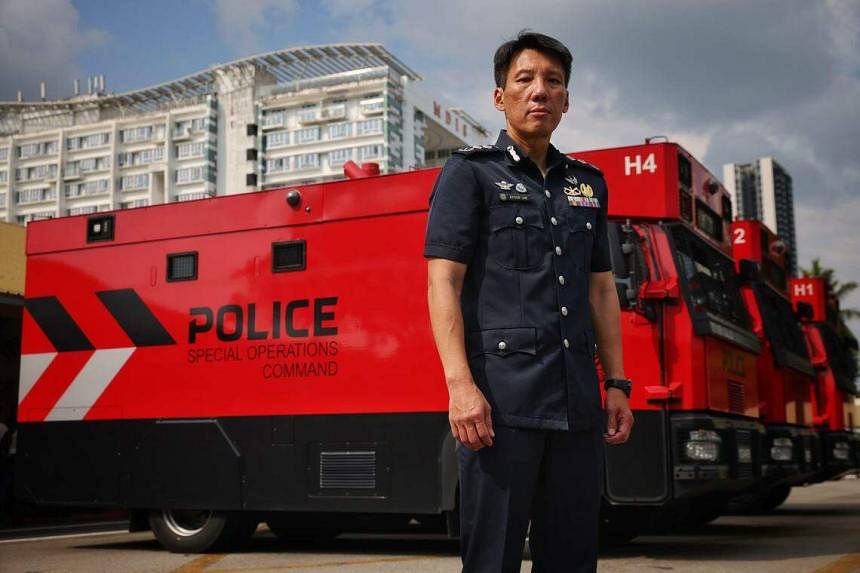
SAC Arthur Law, who was then deputy commander of Central Division, said the riot scene was surreal and he saw vehicles being overturned and torched. ST PHOTO: JASON QUAH
He saw Assistant Superintendent of Police (ASP) Jonathan Tang, who was injured, organising the other officers.
SAC Law said: “I saw blood flowing from his forehead. I was quite taken aback by his injury, and asked him if he was all right.”
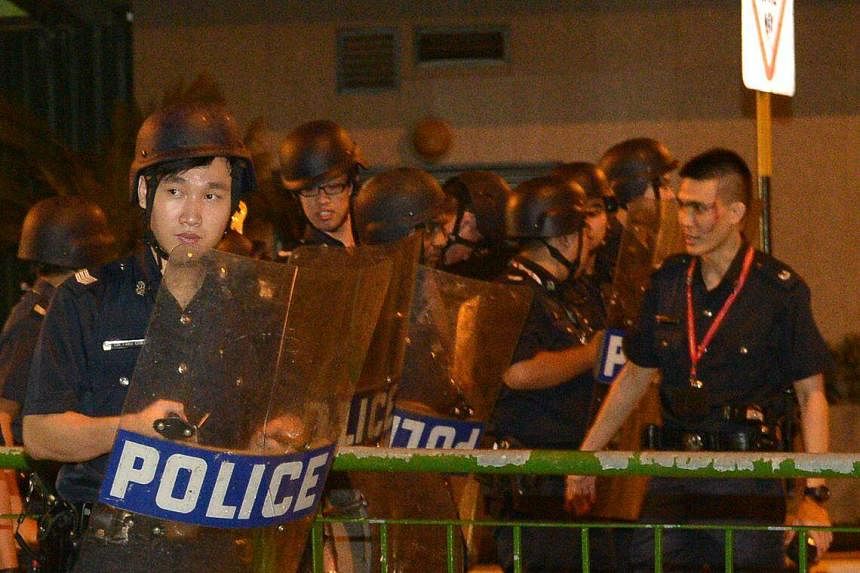
Police at the scene of the riot involving almost 400 people in Race Course Road on Dec 8, 2013. ASP Jonathan Tang (right) was injured after being attacked by rioters. PHOTO: ST FILE
ASP Tang said he was, and continued to hold the line at the junction with SAC Law until the SOC arrived and quelled the riot.
A total of 25 people were arrested at the scene that night.
In the incident, 37 police officers, 12 SCDF officers, five Certis officers and eight members of the public were injured.
More than $530,000 worth of property was damaged, including 23 emergency vehicles.
Deputy Commissioner Daniel Seet, who was then commander of the SCDF’s First Division, recalled how everyone found it difficult to grasp the situation at the start, especially those who were not there that night.

Deputy Commissioner Daniel Seet, who was then commander of the SCDF’s First Division, said SCDF officers felt guilty about retreating from the area. ST PHOTO: GAVIN FOO
He arrived at the scene after the riot was quelled and saw the burning wrecks of vehicles.
“I was walking up and down (Race Course Road), trying to take it all in,” he said.
“I walked past the ambulance that had been set on fire, and it was not easy trying to wrap my mind around what had happened.”
Mr Seet said SCDF officers felt guilty about retreating from the area as they were attacked.
But he said: “I thought tactically that (retreating) was the right call.”
Lessons learnt that night
The COI’s report on the Little India riot found several lapses by the police, although it said that overall the police had responded relatively swiftly and efficiently.The report highlighted several areas for improvement:
Training and equipment
- Apart from the SOC, most of the police officers at the scene were not trained, prepared, or equipped to deal with large-scale rioting.
- Police officers did not have enough equipment, such as helmets and shields, to protect themselves. They also lacked mass communication devices to warn the crowds against rioting.
Communications breakdown
- Radio sets were jammed from too many messages and no one could hear the messages over the noise.
- Different commanders arrived at different locations at different times, making it hard to establish clear command and control.
Poor decision to hold positions
- The decision to have the officers stay put during the second phase of the riot (after the extrication of Mr Sakthivel’s body) meant that the rioters could move about freely in and out of Little India.
- It could also have been perceived by the rioters as inaction by the police, emboldening them as they faced no immediate consequences for their actions.
Late arrests
- If the police had arrested the rioters earlier, they could have prevented the situation from worsening. The COI said there had been opportunities for the police to make arrests when they were not outnumbered, and commanders should have re-evaluated their decisions as the situation changed.
- Joined
- Jul 25, 2008
- Messages
- 13,542
- Points
- 113
‘I thought I’d never see my daughter again’: Little India riot survivor
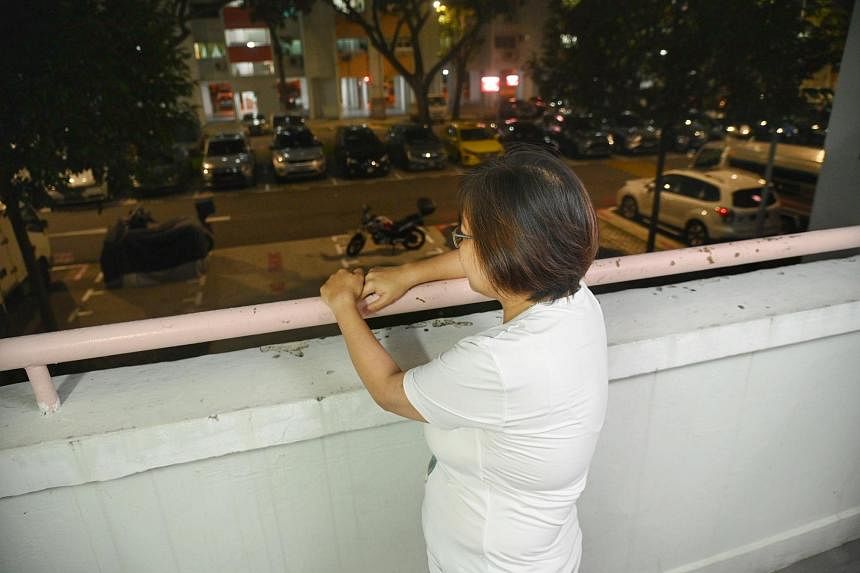
Madam Grace Wong Geck Woon was the bus timekeeper during the riot that happened 10 years ago on Dec 8, 2013. ST PHOTO: DESMOND WEE

Nadine Chua
Dec 3, 2023
SINGAPORE - Cowering under a rubbish bin, she saw a pair of black boots coming towards her as she peeked through the gap between her flimsy shelter and the floor of the private bus.
She had just been hit in the face by a brick that had smashed through the windows of the vehicle she was hiding in.
Hundreds of foreign workers were shaking the bus, screaming for her to be punished after one of their countrymen had been run over by the vehicle and died.
Her left contact lens had fallen out and blood was streaming into her eye from the wide gash on her left eyebrow.
Hardly able to see anything, she did not know if the approaching feet belonged to friend or foe.
Knees to her chest, body trembling, she kept silent and waited for death to come.
Even though the Little India riot happened 10 years ago on Dec 8, 2013, Madam Grace Wong Geck Woon, the bus timekeeper, still remembers everything vividly.
As timekeeper, she was responsible for the movement of buses transporting foreign workers from Little India back to their dormitories in Jalan Papan in Jurong.
She woke up that morning thinking that day would be like any other.
But a traffic accident at 9.21pm which killed Mr Sakthivel Kumaravelu, a construction worker from Tamil Nadu, changed her life.
Within minutes of the accident, she found herself taking cover in the vehicle because of rumours surrounding Mr Sakthivel’s death.
Speaking to The Sunday Times in her Potong Pasir flat on Sept 27, Madam Wong, 48, whose only child was four years old then, recalled in Mandarin: “I don’t know exactly how long I was hiding in the overturned rubbish bin. But it felt like a lifetime. I thought I was going to die, and that I’d never see my daughter again.”
The accident
Mr Sakthivel, 33, was drunk as he boarded the bus that night, and Madam Wong and the bus driver, Mr Lee Kim Huat, asked him to exit the vehicle as they were not permitted to ferry drunk passengers.Mr Sakthivel exited the vehicle, but as it took off in Tekka Lane, he ran after it.
He lost his balance and fell into the path of the front left wheel. It crushed his head and torso, killing him instantly.
Several workers saw this and rumours about the incident spread.
Some said Madam Wong had pushed Mr Sakthivel off the bus, even though she was nowhere near it when the accident occurred. Others said his body was mistreated by first responders.
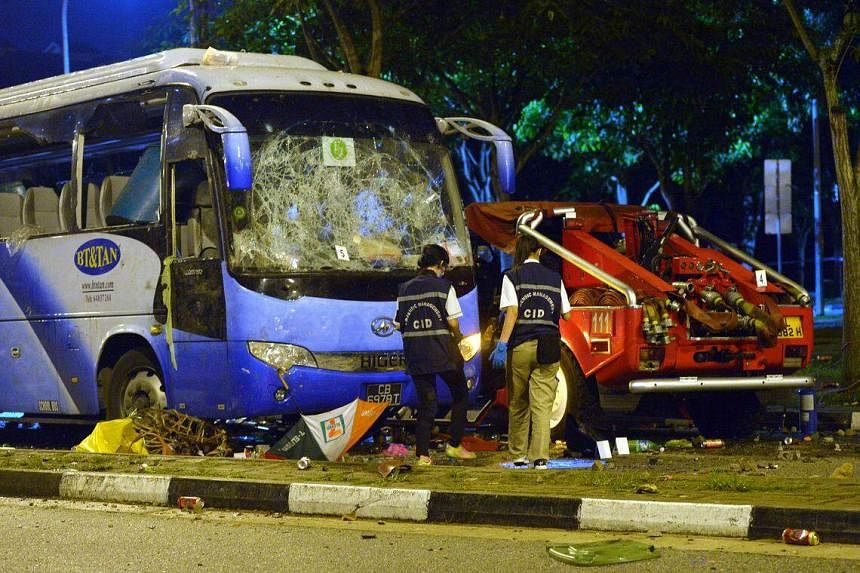
Police officers examining the wrecked private bus on Dec 9, 2013. Chaos broke out in Little India after the fatal accident involving the bus and foreign worker Sakthivel Kumaravelu. PHOTO: ST FILE
The workers were determined to take it out on Mr Lee and Madam Wong.
She was tending to the queue of workers and quickly made her way to the bus when she heard about the accident.
The crowd swelled, and workers threatened Madam Wong and Mr Lee, pushing them towards the vehicle.
They took cover inside the bus and shut its door.
Looking visibly distressed, Madam Wong said all she remembered was cowering in fear, her interlocked hands over her head as workers threw drain covers, bottles and pieces of concrete at the bus, shattering its windows and windscreen.
She said: “Suddenly, someone threw a brick into the bus. I tried to dodge, but it hit my left eye and my contact lens fell out. There was a huge gash on my left eyebrow.”
Blood flowed into her eye and, because it was dark, she could barely see anything.
“At that point, I thought I was going blind,” she recalled.
She said Mr Lee found a rubbish bin the workers had thrown into the bus and asked her to hide under it.
“I didn’t see the time or check how long I was hiding under that bin. But it felt like forever,” she said as she stroked the hair of her daughter Sarina, now 14.
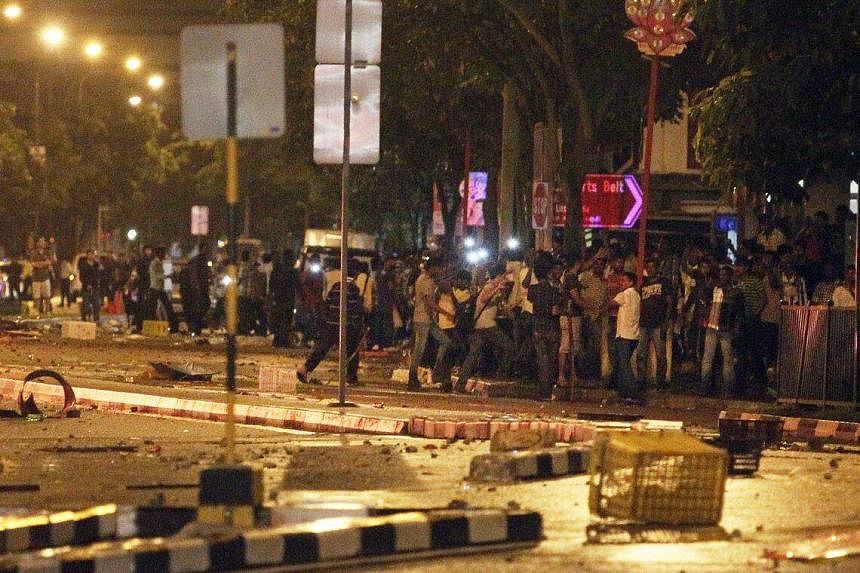
The angry mob threw drain covers, bottles and pieces of concrete at the bus during the 2013 riot, which left 62 people injured and caused more than $530,000 in damage. PHOTO: ST FILE
Then, someone boarded the vehicle.
Madam Wong said: “I could only see through the small gap between the bin and the floor. And I saw that someone wearing black boots was walking towards me.
“I had no idea if this person was going to kill me or save me, so I kept quiet.”
She was relieved when she heard the person say they were the police, and knew she was safe.
According to the Committee of Inquiry convened to find out the cause of the riot and how the authorities had responded to it, Madam Wong and Mr Lee emerged from the bus at around 10.08pm, almost an hour after the accident happened.
Still surrounded by the angry mob, Singapore Civil Defence Force and police officers formed a protective circle around Madam Wong and Mr Lee and escorted them to safety.
Stones, bottles and other projectiles rained down on the shield party, but Madam Wong and Mr Lee were finally taken to Tan Tock Seng Hospital for treatment.
Madam Wong suffered cuts and bruises to her face and legs, and a minor fracture to her right hand. The gash near her left eyebrow required six stitches.
The recovery
The weeks and months that followed were tough on her.She said: “I had nightmares for weeks. I kept crying because I was still scared.”
It was not just her that the riot affected.
“When my daughter saw my injuries, she was very afraid. She kept crying because she had never seen me like this,” said Madam Wong.
Sarina said: “I was very worried when I saw my mum injured like that.”
Madam Wong said her mother-in-law, who lives with them, also cried for several days.
“She asked me if we were safe in our own home, thinking the rioters would find out where we lived,” she recalled.
It was Sarina who got her through those dark days.
Said Madam Wong: “She kept telling me, ‘Mummy, it’s already over. You are safe. You don’t have to be scared any more.’”
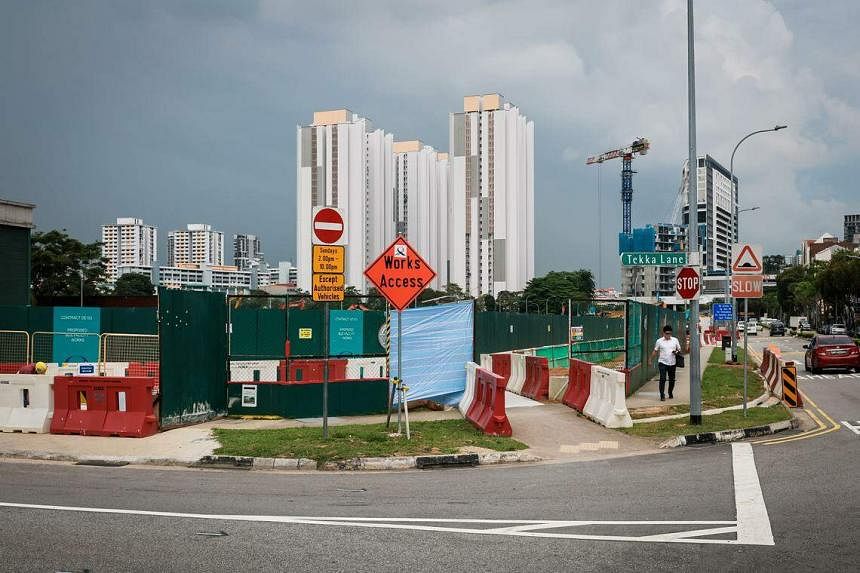
The deceased, Mr Sakthivel Kumaravelu, visited Little India on Sundays and would catch a private bus in Tekka Lane for the trip back to his dormitory in Jurong. ST PHOTO: GAVIN FOO
Madam Wong resigned from her job that month, unable to return to Little India. She took up a job selling children’s clothes at flea markets.
Three years later, still shaken by the incident, she rejected an offer from her boss at the bus company to return to her timekeeping job there.
She said: “My injuries had healed by then, but I was just not ready to go back to where it all happened.”
10 years on
Madam Wong is now a school bus attendant for school-going children, a job she took up seven years ago.The scar on her left eyebrow is hardly visible, and she has fully recovered. But some psychological scars remain.
She said: “When I take a train or a bus and it passes Little India, I’ll get nervous. Or when the doors open as the train stops at Little India and people come flooding in, I’ll tense up.”
But she knew she could not avoid that place forever. “Singapore is small. One way or another, I will definitely have to pass by Little India. So, I told myself I needed to move on with life,” she said.
On a whim, in August, she went to Little India for the first time in a decade.
She said: “On my way home, I alighted at Little India MRT station to switch train lines, and I just decided to visit Tekka Market and Food Centre. I thought it had been a while since I had eaten there.”
Ironically, the market was closed for renovations.
“Maybe next time,” said Madam Wong.
Even though she could not bring herself to visit the accident scene, she has considered taking Sarina to Little India to show her what the place is like.
She said: “I want to teach my daughter that what’s past is past. If something bad happens to you, don’t keep dwelling on it.
“You have to keep going. And I think I did just that.”
- Joined
- Aug 19, 2008
- Messages
- 38,563
- Points
- 113
Loser one word Indians smell.Can give your opinions on race as long as it is not offensive.
S'pore's approach in prohibiting offensive speech but not sharing of opinions on race, protects minorities: Shanmugam

The approach gives greater protection for minorities by making it safe for them to speak about their experiences, said Home Affairs and Law Minister K. Shanmugam.PHOTO: ST FILE

Hariz Baharudin
JUL 5, 2021
SINGAPORE - Singapore's approach, in strictly prohibiting offensive speech on race, but not the sharing of opinions on these matters, gives greater protection for minorities by making it safe for them to speak about their experiences, said Home Affairs and Law Minister K. Shanmugam on Monday (July 5).
He added that if racially offensive speech by all is tolerated or allowed, it can be expected that more of such speech will be directed towards minority communities, who will then bear the brunt of it.
Mr Shanmugam was replying to Ms Raeesah Khan (Sengkang GRC), who had asked if laws against racist hate speech here are consistent with recommendations by the United Nations that state how measures to combat racist speech should not be used as a pretext to curtail expressions of protest.
Singapore's laws against racist hate and offensive speech are consistent with these recommendations, said the minister.
He said that under the Penal Code, it is an offence to commit acts that deliberately wound the racial feelings of any person, promote enmity between different racial groups, or conduct acts that are prejudicial to the maintenance of racial harmony.
"These laws apply equally to everyone, regardless of race," said Mr Shanmugam. He shared two incidents when such laws were used.
In the first, in January 2019, a Chinese man was charged under the Penal Code for deliberately intending to wound the racial feelings of the Malay population. The man had scrawled racist messages about Malays on walls in void decks and sheltered walkways in Geylang and Aljunied.
In the second, in June 2020, a Malay man who used a Twitter account with a Chinese name "@sharonliew86" to make racist remarks against people of different races was similarly charged.
While noting that a significant amount of discussion, commentary and sharing of experiences on race takes place, Mr Shanmugam said that Singapore takes a strict approach to offensive speech and hate speech.
This approach applies equally to all, regardless of majority or minority, which he said gives greater protection for minorities by making it safe for them to speak about their experiences, and to give their views.
Should racially offensive speech be tolerated or allowed, more of such speech will likely be directed towards minority communities, added Mr Shanmugam.
"That will ironically reduce the safe space for discussion of such issues, and increase minority community concerns for safety and security. These are not hypotheticals. This is what has happened in several other countries," he said.
"We need to be careful about changing what has worked reasonably well in Singapore (though it is not perfect), and replacing it with policies which have not worked so well, in other places."
In his reply, Mr Shanmugam also noted that the UN recommendations have similarly taken the view that the protection of people from racist hate speech is not incompatible and is not "simply one of opposition" against the freedom of expression.
The minister added that is not clear in Ms Raeesah's question if she is suggesting that whenever anyone claims to be protesting against "injustice, expressing social discontent, or speaking in opposition", they should be exempted from the Penal Code and be allowed to engage in hate or offensive speech.
The Ministry of Home Affairs has invited her to clarify this, said Mr Shanmugam.
- Joined
- Jul 25, 2008
- Messages
- 13,542
- Points
- 113
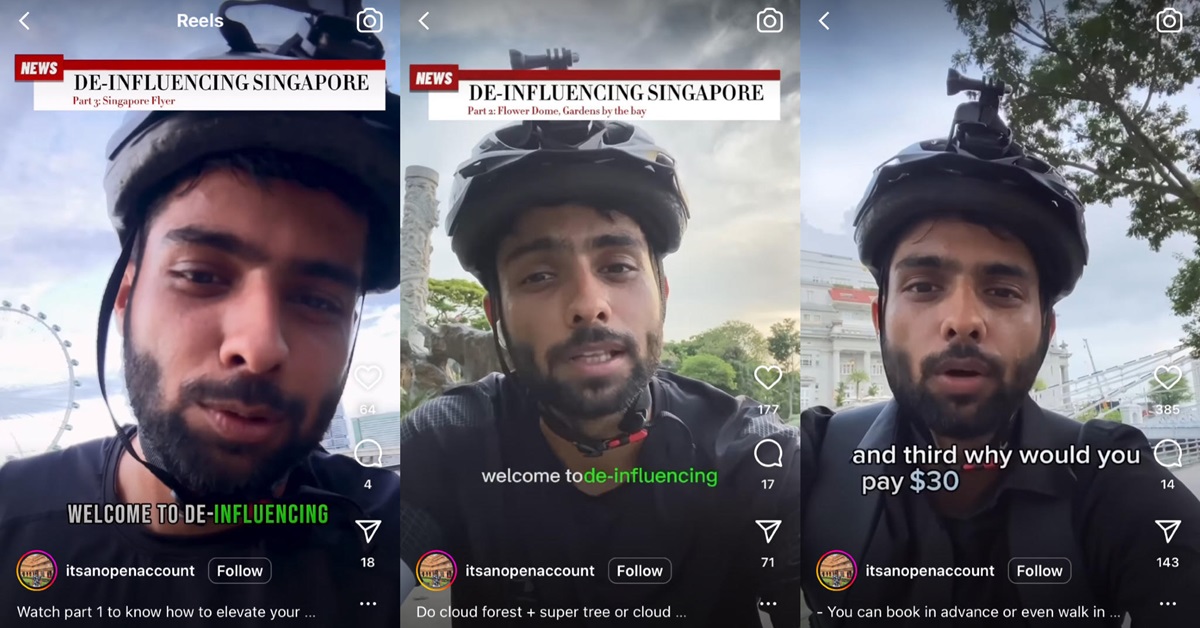
Indian Expat From PwC Gives “Advice to People on How Bad Singapore is Overall”
- Posted Byby ChinHan
- November 29, 2023
Who is Digvijay Pandey?
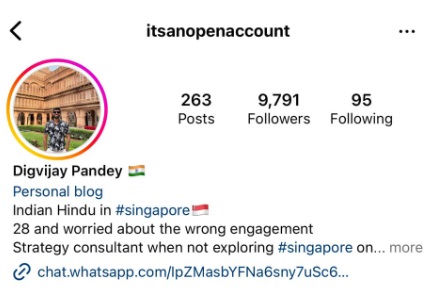
Digvijay Pandey is 28 years old and he is an Indian Hindu based in Singapore. He is currently a Senior Consultant at PwC South East Asia Consulting, and he moved here in June 2022. Before this, he was based in India (Gurugram, Haryana) and worked for Bain & Company and Deloitte. He graduated with a Bachelor’s degree from St Xavier’s College in India, in 2018.


We must not let such foreigners come in to sow discord in our society!
Instead of trying to fit in and appreciate Singapore, he repeatedly uses his race, while complaining that other people are racist. He repeatedly highlights that he “just want(s) my(his) Indian brothers to excel at everything they do”. Only selectively wanting Indians to do well, isn’t that racist in itself?Moreover, he came here and started an Instagram series just to tell everyone how bad Singapore is. Is this the kind of foreign talent we want?
- Joined
- Aug 20, 2022
- Messages
- 17,393
- Points
- 113
FUCK PAP
Indian Expat From PwC Gives “Advice to People on How Bad Singapore is Overall”
Indian Expat working at PWC Singapore Digvijay Pandey (@itsanopenaccount – edit: he changed his Instagram to @overseasdesiinsg) has been using his Instagram to publish videos criticizing Singapore. He made a series called “de-influencing Singapore” complaining about how everything is too expensive. He also tells his viewers that “Singapore is boring”, “Reasons why you shouldn’t waste money visiting Singapore or it’s tourist spots” and “giving advice to people on how bad Singapore is overall”.
- Posted Byby ChinHan
- November 29, 2023
Who is Digvijay Pandey?

Digvijay Pandey is 28 years old and he is an Indian Hindu based in Singapore. He is currently a Senior Consultant at PwC South East Asia Consulting, and he moved here in June 2022. Before this, he was based in India (Gurugram, Haryana) and worked for Bain & Company and Deloitte. He graduated with a Bachelor’s degree from St Xavier’s College in India, in 2018.

From his since-deleted Linkedin
We must not let such foreigners come in to sow discord in our society!
Instead of trying to fit in and appreciate Singapore, he repeatedly uses his race, while complaining that other people are racist. He repeatedly highlights that he “just want(s) my(his) Indian brothers to excel at everything they do”. Only selectively wanting Indians to do well, isn’t that racist in itself?
Moreover, he came here and started an Instagram series just to tell everyone how bad Singapore is. Is this the kind of foreign talent we want?
FUCK CECA








- Joined
- Jul 25, 2008
- Messages
- 13,542
- Points
- 113
Former transport minister S. Iswaran faces 27 charges including corruption, says he is not guilty
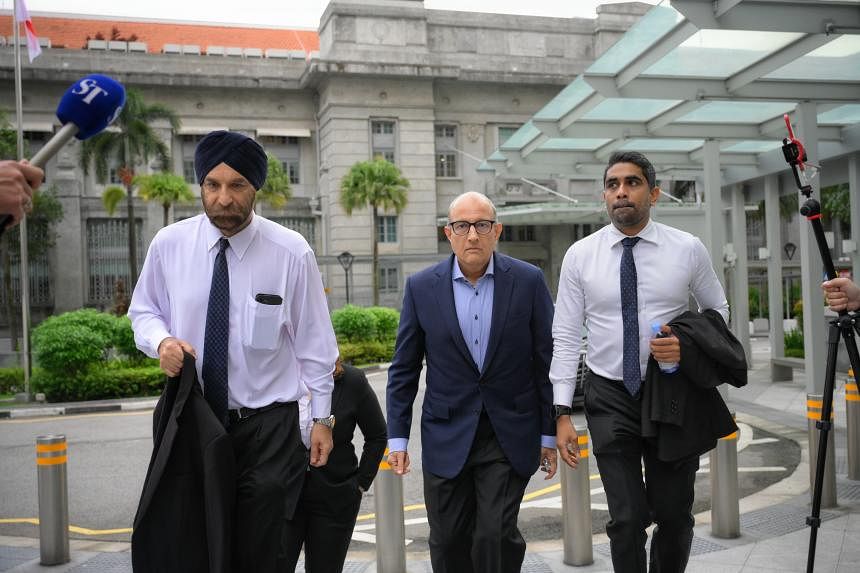
S. Iswaran arriving at the State Courts with his legal team including Senior Counsel Davinder Singh (left), on Jan 18. ST PHOTO: MARK CHEONG
Samuel Devaraj and Shaffiq Alkhatib
JAN 20, 2024
SINGAPORE - Former transport minister S. Iswaran was handed 27 charges on Jan 18, including allegedly obtaining tickets from property tycoon Ong Beng Seng to shows such as Harry Potter And The Cursed Child.
Some of the charges were related to alleged incidents that happened between 2015 and 2021, and included obtaining two tickets to a football match between West Ham United and Everton.
A court officer told the court the charges were read to him before the hearing.
Iswaran, who was arrested in July 2023 by the Corrupt Practices Investigation Bureau (CPIB), arrived at the State Courts at around 8am on Jan 18. He arrived with his legal team, which included Senior Counsel Davinder Singh from Davinder Singh Chambers, and did not comment when The Straits Times approached him.
The prosecution team is led by Chief Prosecutor Tan Kiat Pheng, who is assisted by Deputy Chief Prosecutor Jiang Ke-Yue and Deputy Public Prosecutor Kelvin Chong.
When the judge asked Iswaran how he intended to plead, he said: “Not guilty.”
He is now out on $800,000 bail.
The charges are two counts of corruption, 24 counts of obtaining items from someone he had business dealings with as a public servant, and one of obstructing the course of justice. The value of the items in the charges is more than $380,000.
Mr Singh said cautioned statements were taken from Iswaran on 36 charges on Jan 15.
He said the defence learnt on the morning of Jan 18 that there were now just 27 charges, and asked if the prosecution was proceeding with the remaining nine charges.
The prosecution said it was not.
Court documents show that most of the offences Iswaran faces involve Mr Ong, who brought Formula One to Singapore in 2008.
In September 2022, Iswaran had allegedly corruptly obtained from Mr Ong gratification with a total value of about $145,434 as inducement for advancing his business interests in matters relating to a contract between Singapore GP and the Singapore Tourism Board (STB).
The alleged gratification included 10 Green Room tickets, eight Twenty3 tickets and 32 general admission tickets to the 2022 Singapore Formula 1 Grand Prix.
He allegedly obtained from Mr Ong gratification valued at $20,848.03 in December 2022 for advancing his business interests in matters relating to a contract between Singapore GP and the STB and a proposal for a contract with the STB.
The alleged bribes included an outbound flight on Mr Ong’s private plane from Singapore to Doha worth about US$7,700 (S$10,410.40), one night’s stay in Four Seasons Doha worth about $4,737.63, and a business class flight from Doha to Singapore worth about $5,700.
He had allegedly obtained, as a public servant, valuable things with a total value of about $218,058.95 from Mr Ong on 24 occasions between November 2015 and December 2021.
He allegedly either obtained this through Mr Ong directly, Singapore GP or Como Holdings (UK) – a member of Como Group that was founded and is owned by Mr Ong’s wife, Mrs Christina Ong.
He allegedly did so while knowing Mr Ong had a connection with his official function as chairman of the F1 Steering Committee.
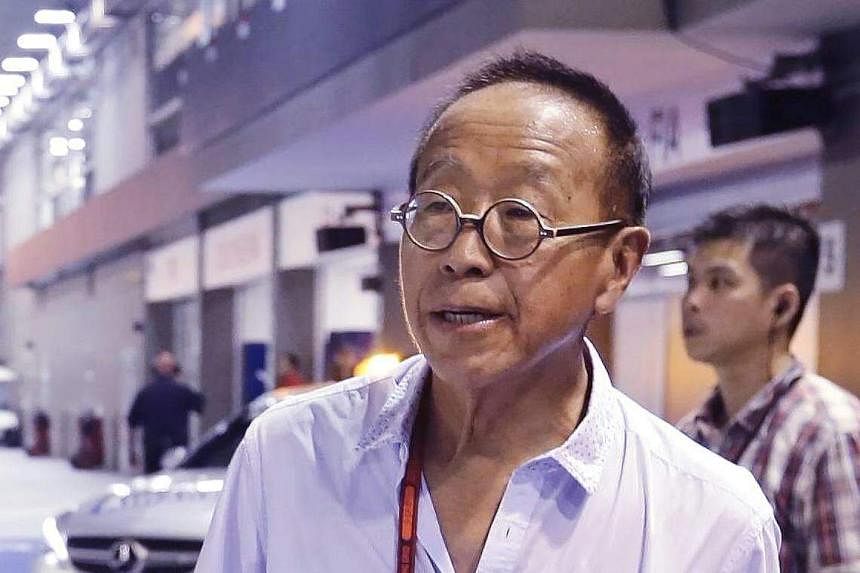
Court documents show that most of the offences Iswaran faces involve property tycoon Ong Beng Seng (pictured), who brought Formula One to Singapore in 2008. PHOTO: ST FILE
The items include two tickets to a football match between West Ham United and Everton worth about £468 (S$1,006.06) that he obtained around November 2015, and 10 Green Room tickets to the 2017 Singapore Formula One Grand Prix worth about $42,265 that he obtained in September 2016.
He allegedly in September 2018 obtained 13 general admission tickets to the 2018 Singapore Formula One Grand Prix worth about $16,744.
He purportedly obtained tickets to multiple shows including Hamilton, Kinky Boots, Book Of Mormon and Harry Potter And The Cursed Child.
Iswaran had allegedly obstructed the course of justice on or about May 25, 2023.
He had allegedly made repayment of $5,700 – the cost of his business class flight ticket from Doha to Singapore that he had taken on Dec 11, 2022, at Mr Ong’s expense – through Singapore GP.
Iswaran, 61, was arrested by CPIB on July 11, 2023, following its investigation into a separate matter.
He was instructed by Prime Minister Lee Hsien Loong to take a leave of absence until investigations were completed. His monthly pay was reduced to $8,500.

Iswaran, 61, was arrested by CPIB on July 11, 2023, following its investigation into a separate matter. He was then released on bail. ST PHOTO: KELVIN CHNG
Iswaran was elected in 1997 as an MP for West Coast GRC (group representation constituency), where he has served for the last 26 years.
He was promoted to full minister in the Prime Minister’s Office in 2011.
Mr Ong was also arrested on July 11 as part of the corruption probe.
On Jan 18, a spokesperson from AGC said: “The Attorney-General’s Chambers will take a decision in respect of the investigations against Mr Ong and others, after the case against Mr S. Iswaran has been completed, including the presentation of evidence in court.”
Iswaran issued a statement after his court appearance, saying: “I am innocent and will now focus on clearing my name.
“My family and I are deeply touched by the continued support, kindness and encouragement of our friends and well-wishers.”
Iswaran charged 6 months after CPIB arrest: How the case unfolded
Nothing to suggest F1 S'pore GP contracts disadvantaged Govt: MTI
Earlier, Deputy Prime Minister Lawrence Wong told reporters that the Government had handled the matter decisively and proactively.
He said he was disappointed and saddened by what had happened, and said the People’s Action Party’s stance on corruption was non-negotiable.
He said: “This is part of our DNA. There can be no compromise, no relaxation, no fudging of this, no matter the political price.
“The PAP Government will continue to do everything we can to uphold the highest standards of integrity, incorruptibility and propriety. That’s how we maintain the trust that Singaporeans have placed in us.”
Iswaran’s pre-trial conference is scheduled for March 1.
For each corruption charge, he can be fined up to $100,000, jailed for up to seven years, or both.
He can be fined, jailed for up to two years or both, for obtaining valuable items from someone he had business dealings with as a public servant.
For obstructing the course of justice, he can be jailed for up to seven years, fined or both.
- Joined
- Jul 25, 2008
- Messages
- 13,542
- Points
- 113
Violet Oon wins court bid to buy out business partner

Cooking doyenne Violet Oon (seated) with her son Tay Yiming (left), daughter Tay Su-lyn and business partner Manoj Murjani in 2018. PHOTO: ST FILE

Selina Lum
Senior Law Correspondent
JAN 19, 2024
SINGAPORE – Peranakan cuisine icon Violet Oon has won her court bid to buy out businessman Manoj Murjani, who holds a 50 per cent stake in her eponymous restaurant business through his holding company.
Ms Oon and her two children, who own the other half of the business, said Mr Murjani had pressured them into signing a new agreement under duress in 2019 after he learnt that the trio had increased their salaries.
Under this agreement, the company purportedly owed $1.55 million to Mr Murjani’s company, Group MMM.
If this supposed loan was not repaid, it would potentially be converted into equity for Group MMM, giving Mr Murjani a majority shareholding.
In a written judgment issued on Jan 19, High Court judge Philip Jeyaretnam found that Mr Murjani had exerted economic duress and undue influence in order to change the shareholder arrangements with a view to his taking control of the company.
Justice Jeyaretnam said: “Given the unfairly exploitative and manifestly disadvantageous nature of the 2019 agreements and the claimants’ testimony concerning the negotiations and the pressure they felt under, I find that the claimants would not have entered into them but for the illegitimate pressure exerted on them.”
The judge said the economic duress made the agreement invalid.
He granted an order sought by the family to buy out Group MMM’s stake in the company.
The company Violet Oon was set up in 2012 by Ms Oon, her daughter Tay Su-Lyn and her son Tay Yiming.
Ms Oon was the company’s culinary curator and chef; Ms Tay was the creative director, marketing manager, and events and catering manager; and Mr Tay was the general manager and managing director.
In 2014, Mr Murjani acquired 50 per cent of the company for $450,000.
At the time, Ms Oon drew $5,000 a month, Ms Tay $1,000 and Mr Tay $4,500. By November 2018, the salaries increased respectively to $8,000, $5,000 and $8,000.
After Mr Murjani found out about this in December 2018, he accused the family of overpaying themselves and took the view that he should be compensated by the company to balance off the salary increments.
He initially claimed that the overpayment amounted to $511,804. This figure was eventually revised to $1.25 million.
During a meeting with Mr Tay in February 2019, Mr Murjani proposed that Group MMM should get 70 per cent of the company based on the value of his contributions.
On Feb 21, 2019, Mr Murjani e-mailed Mr Tay a list of terms, to which the family agreed.
One of the terms stated that Group MMM would receive from the company $1.55 million, which included $1.25 million “overpaid” to the trio.
Another term was for Ms Oon and Ms Tay to be removed from the board, leaving only Mr Tay and Mr Murjani as directors. Mr Murjani was also to be appointed chairman and chief executive of the company.
Other terms related to the company’s branding, including shifting the brand to “VO Singapore” instead of “Violet Oon” and redoing public relations materials to feature Mr Murjani and Group MMM.
A new shareholders’ agreement was signed on Feb 26, 2019.
In 2022, Ms Oon and her children, who are represented by a team led by Ms Meryl Koh from Drew & Napier, filed a lawsuit alleging oppression.
The family also sought an order for Group MMM to sell its shares in the company to them, at a price to be determined by the court or a court-appointed valuer.
On April 5, 2023, Group MMM offered to buy out the family for $6 million, on the condition that the family cannot use the “Violet Oon” name.
The family rejected the offer, and the case went to trial on July 10, 2023.
In his judgment, Justice Jeyaretnam said this offer was “not reasonable” because it did not address what Ms Oon and her children wanted, which was to buy out Group MMM, and was premised on Group MMM using Ms Oon’s name.
He said Mr Murjani had used the salary dispute as an opportunity to confuse and pressure Mr Tay by using “tactics” such as threatening severe consequences, inflating the amount of overpayment and exaggerating Group MMM’s contributions.
Mr Tay testified that Mr Murjani had threatened to wind up the company and expose the family to financial claims as they had given personal guarantees for bank loans.
Mr Murjani denied the allegations, but Justice Jeyaretnam concluded that the businessman had made his meaning clear without being explicit.
“From my observation of him in the witness box, he appears to be someone equipped with an ability to manipulate others emotionally without spelling things out,” said the judge.
In a statement to the media, the family said the judgment represented “a fair and just outcome” and that they feel vindicated by the court’s findings.
- Joined
- Jul 25, 2008
- Messages
- 13,542
- Points
- 113
- Joined
- Jul 25, 2008
- Messages
- 13,542
- Points
- 113
Parents seek refunds from international school over delay in new campus construction
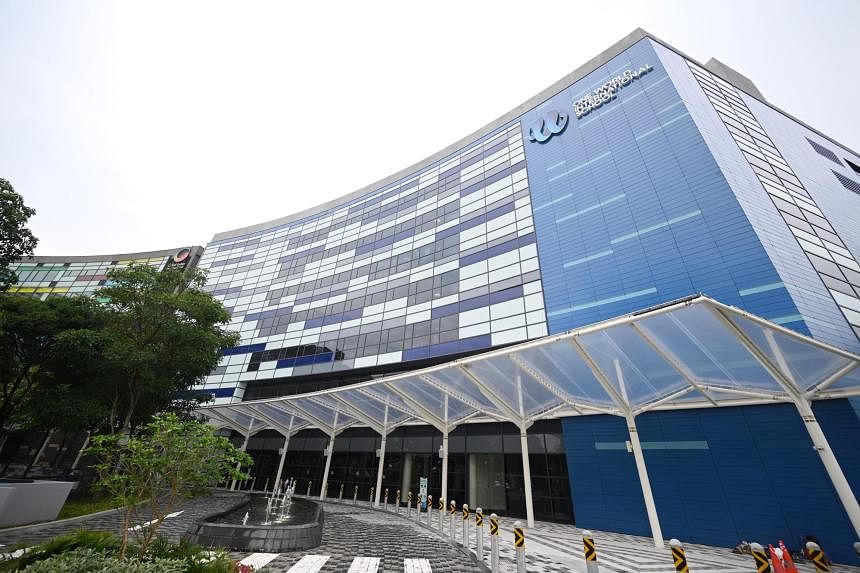
The One World International School’s Punggol campus was slated to be operational by August 2023, parents said. ST PHOTO: AZMI ATHNI

Gabrielle Chan
APR 21, 2024
SINGAPORE - Some parents of students of an international school are demanding refunds for a $6,000 building fee, as the school’s Punggol campus was not ready as expected.
The One World International School’s (OWIS) Punggol campus was slated to be operational by August 2023, the start of the school’s academic year, parents said. But their children had to share a campus with a school next door for seven months until March 2024.
OWIS Punggol, which has around 300 students across pre-school, primary school and secondary school levels, is located at 27 Punggol Field Walk. Its neighbouring school is Global Indian International School (GIIS).
Mr Siddharth Bolurker, 42, told The Straits Times that he transferred his 12-year-old daughter from the OWIS campus in Nanyang to the one in Punggol as it is nearer his house.
He paid nearly $25,000 for a year’s worth of school fees, including the building fee.
However, from August 2023 to March 2024, his daughter and other students were housed at GIIS. They shared the campus – including classrooms, canteen and play spaces – with GIIS students.
Mr Bolurker, a solutions engineer, said: “One of the main concerns while enrolling in the Punggol campus was whether it would be ready in time, because we saw that work was still ongoing.
“But when we asked the staff at the open house, they explicitly said not to worry and the new campus would be operational when school starts.”
OWIS has two other campuses – Nanyang, which is in Jurong West, and Suntec, which will be closing in June 2024.
OWIS was acquired by Global Schools Foundation, a non-profit organisation, in 2015.
The Nanyang campus opened in 2018, followed by the Suntec campus in 2021, and the Punggol Digital campus in 2023.
OWIS Punggol is able to hold up to 1,500 students, according to its website.
In response to queries from ST, a spokesman for OWIS said its Punggol Digital Campus has been “operational since August 2023 in the shared premises as per approval received from all regulatory authorities”. The school did not specify what these shared premises were.
He added that parents were given a campus tour of the shared premises and “briefed well in advance” before admissions.
“The same information was communicated during open houses, counselling sessions and one-on-one interactions with the OWIS staff,” he said.
The campus was granted its temporary occupation permit (TOP) only in February, said the spokesman, adding that this was shared with the parents.
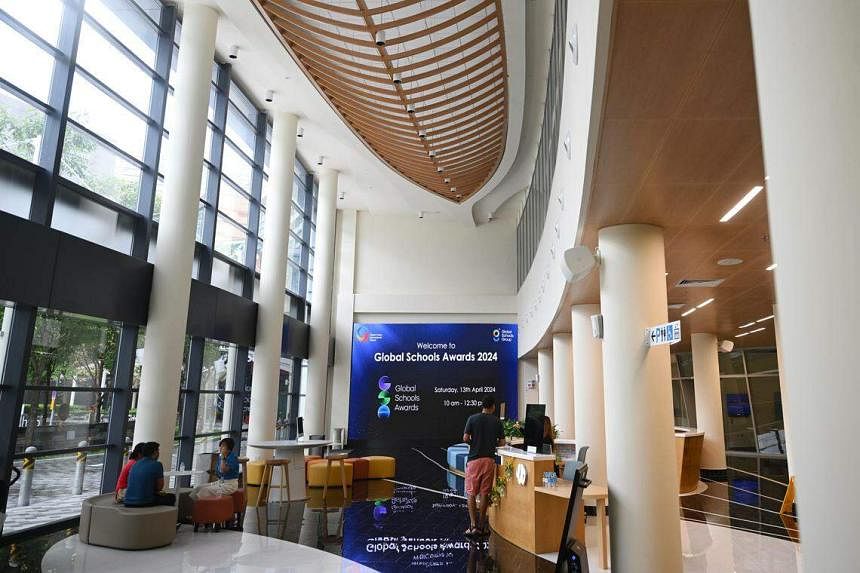
The One World International School’s Punggol campus has around 300 students across pre-school, primary and secondary school levels. ST PHOTO: AZMI ATHNI
In a statement on its website, OWIS said on March 15 that it had received approval from the Committee for Private Education, and that its students could attend classes at the new facility from March 18.
The TOP, issued by the Building and Construction Authority, is a permit that allows residents to reside in a development that is habitable but incomplete.
One parent, a 45-year-old sustainability building design professional, said he was told by school representatives and principal Angela Henderson via two Zoom calls and one in-person meeting that his 12-year-old son would be able to attend the school at its new premises from August 2023.
He said the school initially promised a fully functional campus, and that the opening was postponed multiple times, eventually opening in April after several delays.
Even though students moved to the new campus on March 15, he added that he felt the move was rushed and many facilities were not ready for use.
He was one of several parents who expressed concern about the new campus, noting that facilities like computer and science labs were incomplete, some toilets were inaccessible, and cleanliness was compromised by construction debris.
One parent, who spoke on condition of anonymity, said it looked like the school had “prepared the building in a hurry to start”.
OWIS did not respond to ST’s queries about the condition of the school’s amenities.
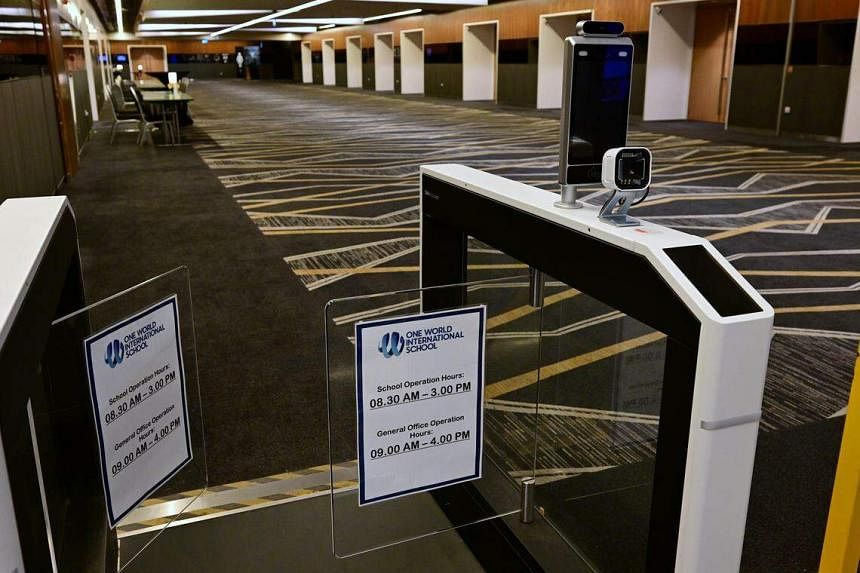
OWIS has two other campuses – Nanyang, which is in Jurong West, and Suntec (above), which will be closing down in June 2024. ST PHOTO: NG SOR LUAN
Prior to the move, a group of 70 parents e-mailed the school on Feb 21 asking for a refund of the building fee, expressing concern about the delay of the new campus, and dissatisfaction with the compensation offered.
The e-mail, which was seen by ST, said the school had offered summer school and extracurricular activities as a form of compensation for the building fee. In response, parents said they were “not convinced nor interested”, and “do not believe these offerings justify the fees charged”.
“Students are relegated to playing in the bus bay due to a lack of proper sports facilities, with no competitive sports activities held against other schools as initially promised,” the e-mail added.
OWIS did not respond to queries about whether parents will be receiving other forms of compensation.
A parent, who requested to remain anonymous, said co-curricular activities were limited to football, cricket and badminton, and often could not be conducted due to events at GIIS.
The 38-year-old mother of two sons aged eight and 10 said that as at April, the sports field at the new campus is still under construction.
She added: “The management does not understand the significance of losing a year’s worth of valuable opportunities for physical activity during adolescence. The students felt very marginalised while borrowing the facilities from GIIS.”
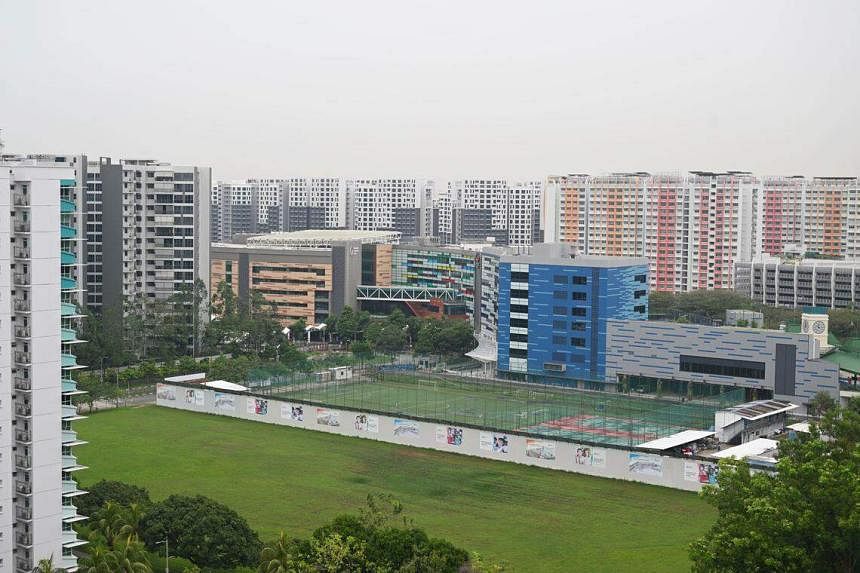
A parent who requested to remain anonymous said the sports field at OWIS Punggol is still under construction. ST PHOTO: AZMI ATHNI
The OWIS spokesman said: “Feedback or concerns received from these communications were respectively responded to, and the parent community was very appreciative of the facilities and infrastructure of the campus, and the proactive lines of communication from the OWIS team.”
He added that the school followed all procedures prescribed by the regulatory authorities to run.
But parents are frustrated and lack confidence in the school’s management, said Mr Oleg Prosvetov, 42, a sales engineering manager with an eight-year-old daughter in the school.
“We don’t want to switch schools as it is quite disruptive for our daughter, but we do plan to go to the Small Claims Tribunals,” he said.
The parent who is a sustainable building design professional and another parent said they will be moving their children to other schools. Others are hoping for a refund of their building fees and for the new campus to be fully operational as soon as possible.
Last edited:
start investigation soon. These days money in everyone’s pocket no enoughParents seek refunds from international school over delay in new campus construction

The One World International School’s Punggol campus was slated to be operational by August 2023, parents said. ST PHOTO: AZMI ATHNI

Gabrielle Chan
APR 21, 2024
SINGAPORE - Some parents of students of an international school are demanding refunds for a $6,000 building fee, as the school’s Punggol campus was not ready as expected.
The One World International School’s (OWIS) Punggol campus was slated to be operational by August 2023, the start of the school’s academic year, parents said. But their children had to share a campus with a school next door for seven months until March 2024.
OWIS Punggol, which has around 300 students across pre-school, primary school and secondary school levels, is located at 27 Punggol Field Walk. Its neighbouring school is Global Indian International School (GIIS).
Mr Siddharth Bolurker, 42, told The Straits Times that he transferred his 12-year-old daughter from the OWIS campus in Nanyang to the one in Punggol as it is nearer his house.
He paid nearly $25,000 for a year’s worth of school fees, including the building fee.
However, from August 2023 to March 2024, his daughter and other students were housed at GIIS. They shared the campus – including classrooms, canteen and play spaces – with GIIS students.
Mr Bolurker, a solutions engineer, said: “One of the main concerns while enrolling in the Punggol campus was whether it would be ready in time, because we saw that work was still ongoing.
“But when we asked the staff at the open house, they explicitly said not to worry and the new campus would be operational when school starts.”
OWIS has two other campuses – Nanyang, which is in Jurong West, and Suntec, which will be closing in June 2024.
OWIS was acquired by Global Schools Foundation, a non-profit organisation, in 2015.
The Nanyang campus opened in 2018, followed by the Suntec campus in 2021, and the Punggol Digital campus in 2023.
OWIS Punggol is able to hold up to 1,500 students, according to its website.
In response to queries from ST, a spokesman for OWIS said its Punggol Digital Campus has been “operational since August 2023 in the shared premises as per approval received from all regulatory authorities”. The school did not specify what these shared premises were.
He added that parents were given a campus tour of the shared premises and “briefed well in advance” before admissions.
“The same information was communicated during open houses, counselling sessions and one-on-one interactions with the OWIS staff,” he said.
The campus was granted its temporary occupation permit (TOP) only in February, said the spokesman, adding that this was shared with the parents.

The One World International School’s Punggol campus has around 300 students across pre-school, primary and secondary school levels. ST PHOTO: AZMI ATHNI
In a statement on its website, OWIS said on March 15 that it had received approval from the Committee for Private Education, and that its students could attend classes at the new facility from March 18.
The TOP, issued by the Building and Construction Authority, is a permit that allows residents to reside in a development that is habitable but incomplete.
One parent, a 45-year-old sustainability building design professional, said he was told by school representatives and principal Angela Henderson via two Zoom calls and one in-person meeting that his 12-year-old son would be able to attend the school at its new premises from August 2023.
He said the school initially promised a fully functional campus, and that the opening was postponed multiple times, eventually opening in April after several delays.
Even though students moved to the new campus on March 15, he added that he felt the move was rushed and many facilities were not ready for use.
He was one of several parents who expressed concern about the new campus, noting that facilities like computer and science labs were incomplete, some toilets were inaccessible, and cleanliness was compromised by construction debris.
One parent, who spoke on condition of anonymity, said it looked like the school had “prepared the building in a hurry to start”.
OWIS did not respond to ST’s queries about the condition of the school’s amenities.

OWIS has two other campuses – Nanyang, which is in Jurong West, and Suntec (above), which will be closing down in June 2024. ST PHOTO: NG SOR LUAN
Prior to the move, a group of 70 parents e-mailed the school on Feb 21 asking for a refund of the building fee, expressing concern about the delay of the new campus, and dissatisfaction with the compensation offered.
The e-mail, which was seen by ST, said the school had offered summer school and extracurricular activities as a form of compensation for the building fee. In response, parents said they were “not convinced nor interested”, and “do not believe these offerings justify the fees charged”.
“Students are relegated to playing in the bus bay due to a lack of proper sports facilities, with no competitive sports activities held against other schools as initially promised,” the e-mail added.
OWIS did not respond to queries about whether parents will be receiving other forms of compensation.
A parent, who requested to remain anonymous, said co-curricular activities were limited to football, cricket and badminton, and often could not be conducted due to events at GIIS.
The 38-year-old mother of two sons aged eight and 10 said that as at April, the sports field at the new campus is still under construction.
She added: “The management does not understand the significance of losing a year’s worth of valuable opportunities for physical activity during adolescence. The students felt very marginalised while borrowing the facilities from GIIS.”

A parent who requested to remain anonymous said the sports field at OWIS Punggol is still under construction. ST PHOTO: AZMI ATHNI
The OWIS spokesman said: “Feedback or concerns received from these communications were respectively responded to, and the parent community was very appreciative of the facilities and infrastructure of the campus, and the proactive lines of communication from the OWIS team.”
He added that the school followed all procedures prescribed by the regulatory authorities to run.
But parents are frustrated and lack confidence in the school’s management, said Mr Oleg Prosvetov, 42, a sales engineering manager with an eight-year-old daughter in the school.
“We don’t want to switch schools as it is quite disruptive for our daughter, but we do plan to go to the Small Claims Tribunals,” he said.
The parent who is a sustainable building design professional and another parent said they will be moving their children to other schools. Others are hoping for a refund of their building fees and for the new campus to be fully operational as soon as possible.
- Joined
- Jul 25, 2008
- Messages
- 13,542
- Points
- 113
Why cheating comes naturally to Indians

Palash Krishna MehrotraFeb 25, 2018 | 13:38

Scams are generational
When an Indian child is growing up, her parents ask her at some point: "Beta, which one is your favourite scam?" The kind of scam you like reveals a personality type—a guide to the future, indispensable to worried parents. My answer as a schoolboy was unwavering: "Mummy, fodder scam."Scams are generational. Those who are born about now will ten years later have their own favourites: Rotomac, NiMo and others that will show up in the time to come.
We Indians are born fraudsters and hustlers. The big guns obviously hunt bigger game. The returns are higher. Every Indian cheats to the best of her ability. You do the best you can. It’s what school taught us.
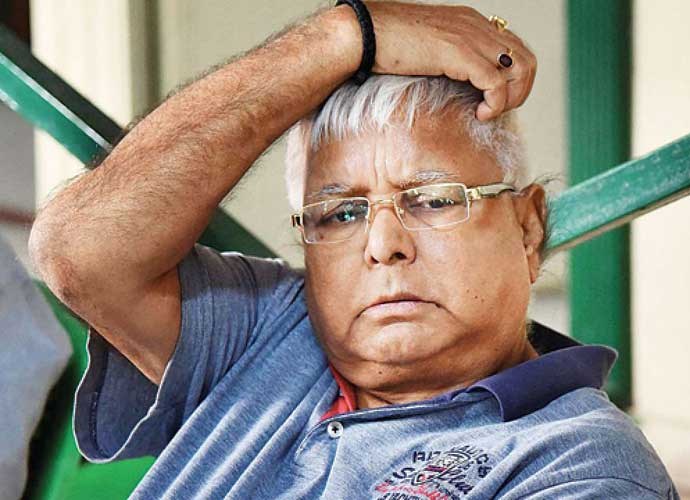
To learn to cheat in India is to learn how to survive. If you don’t, society will treat you as an imbecile who never grew up. Like the freelance writer.
The working principle is this: If you don’t exploit, then you will automatically become the exploited. What happens then is that since everyone is cheating everybody else, all this cheating cancels each other out in the final sum. No one really gains. But it’s something we are habituated and genetically inclined to do, like the way we drive. It’s a mix of nature and culture.
The shopkeeper wakes up and ups his shutters. The spider waits for the fly to come flying in. It could be the smallest of shopkeepers. It’s the reason people don’t change neighbourhoods, although familiarity is no guarantee that you will not be cheated. There is a cold bloodedness to our human relationships: false obsequiousness always follows a successful heist. The cheater respects the cheated’s stupidity. Without that he will be nothing.
This cheating can be about the smallest of things, beginning with plumbers, electricians, carpenters, the cab ride from the airport or train station.
The cigarette seller will keep five rupees and refuse to return the change.
The mobile phone shop man will take a look at you, size you up, then quote you an inflated price for a phone cover and case.
The parking attendant will take an extra ten for parking.
Every tourist is fair game, which is why we have to chaperone, baby sit and play tourist-guide to our foreign guests. They can’t be left alone. They will be fleeced.
You will hand in a five hundred rupee note, the cashier will keep it and return much less than you’d calculated. When you say "Hey, what happened to the rest?", he’ll reply: "Oh sorry I thought you gave me a hundred." He’s testing you. On your face he will make you feel that you’re being unnecessarily difficult. Secretly, he respects you.
The building contractor will cheat. The property dealer will dip his hand in the flowing Ganges. The developer has his hand permanently stuck in the riverbed.
That’s the reason why Indian parents always warn their kids: Don’t let your guard down for a moment. The moment you do, you’ve been had.
To come back to my earlier point, in a system where everyone is cheating everyone there’s a way of things evening out. The system is always in a state of equilibrium.
The shopkeeper will cheat the customer. The shopkeeper will have a heart attack. He will go to a hospital. Here, he is the customer. The hospital will duly fool him, charging an exorbitant amount for tests and medicines. They might throw in an unnecessary stent or three.
Now the guy who owns the hospital will have a boy who needs to go to school. The school will make him part with huge sums of money in lieu of admission, for uniforms, notebooks and text books. The teacher in the school will make the doctor’s son come to him for extra tuitions.
The school teacher’s computer will pack up. He will go to Nehru Place where the computer shop will rip him off for repairs.
Flush with cash the computer shop man will go to the theka where he will be overcharged for the booze. But the theka owner is already supplying several bottles a month for free to the local police station.
Similarly, the fruit seller will invariably overcharge you if you don’t look from around the neighbourhood. But he has to pay hafta to the local goon. Or cop. Or the MCD.
The auto guy will cheat you but when his auto breaks down the auto repair guy will cheat him.
The fancy gift shop guy will put whimsical price stickers on smuggled items, doubling his profits. But remember his mother-in-law will get cancer, which is when the hospital will get the chance to screw him.
Why, for all our family values, family members cheat each other all the time. Especially when it comes to matters of property. The younger brother will keep squatting on prime ancestral property after the patriarch/ matriarch has died and refuse to vacate.
And so on.
Basically if you don’t look local enough, you don’t bargain hard and question every transaction, you will be a sitting duck. That’s the default Indian setting. No Indian trusts the next Indian. Trust signals gullibility, not a valued trait in our urban jungle.
This is also the reason why scams don’t bother us much. The current form of our cricket team, and cricketer weddings, is our only moral worry.
One could argue that instead of waking up and making a c of people first thing, why don’t we just carry out our transactions honestly?
Put this question to the devious Indian yourself and see what he has to say.
Just don’t believe what he’s telling you.
- Joined
- Jul 25, 2008
- Messages
- 13,542
- Points
- 113
Singapore Airlines ordered to pay $3,580 to couple after recliner seats failed to work
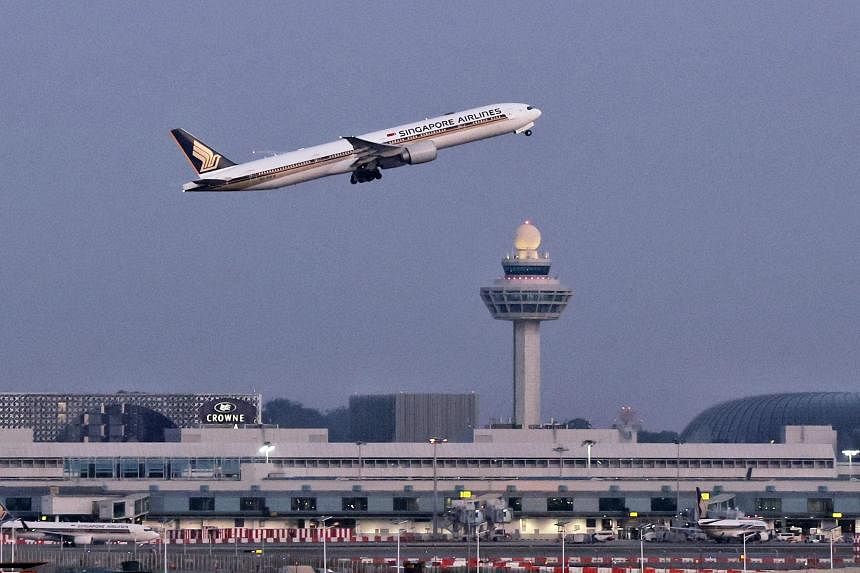
The airline had offered the couple 10,000 KrisFlyer miles each, but they declined the offer. ST PHOTO: KEVIN LIM

Fatimah Mujibah
APR 27, 2024
Singapore Airlines (SIA) has been ordered to pay two of its passengers 200,000 rupees (S$3,300) plus other costs after they filed a complaint concerning recliner seats on a flight from Hyderabad to Singapore.
Mr Ravi Gupta, the director-general of police in India’s Telengana state, was travelling with his wife on May 23, 2023, in business class, but found that their seats could not recline electronically.
Mr Ravi said the malfunction caused them inconvenience, and he had to stay awake throughout the almost four-hour flight despite paying 133,500 rupees in total for the plane tickets.
He made a complaint to the District Consumer Disputes Redressal Commission-III in Hyderabad, which ordered SIA to return 97,500 rupees to the couple, along with an interest charge of 12 per cent from the date of complaint.
Additionally, the airline would also have to bear the cost of 100,000 rupees for the duo’s “mental agony and physical suffering”, along with paying 10,000 rupees to cover the cost for the complaint.
The total sum amounts to around $3,580.
The airline had offered the couple 10,000 KrisFlyer miles each, but they declined the offer.
They had purchased Business Z class seats. The Z class fare is flexible and refundable.
The seats in business class are supposed to be able to recline automatically via electronic buttons.
In their complaint, the couple claimed that they felt as if they were economy class passengers, except they had extra leg room, reported the Deccan Chronicle.
In a statement to The Straits Times, SIA acknowledged the decision of the commission.
“SIA can confirm that while the automatic recline function on Mr and Mrs Gupta’s seats was faulty, the manual recline function was working. We apologise to Mr and Mrs Gupta for the inconvenience caused by this mechanical issue,” said the airline.
“As it was a full flight, SIA staff unfortunately could not reseat them elsewhere in the business class cabin. During the flight, our crew proactively checked in on these customers regularly and offered to manually recline the seat when needed,” added SIA.
The airline did not answer queries on whether it would pay the couple as ordered or appeal against the decision.
Meanwhile, Indigo Airlines was ordered to pay a passenger 30,000 rupees for not informing him earlier of his flight cancellation.
The man’s flight was scheduled for 10.05am, while the airline sent the message at 4.31am the same day, reported The New Indian Express.
He saw the message only at 8am, while he was on his way to the airport.
The airline said that the flight cancellation was due to “operational constraints that were beyond their control”, but was not able to produce evidence of this later on.
- Joined
- Jul 25, 2008
- Messages
- 13,542
- Points
- 113
India asks its citizens to cut fat, salt and sugar intake

The revised dietary guidelines have been widely welcomed in India, which is witnessing a rapid growth in diseases such as diabetes. ST PHOTO: DEBARSHI DASGUPTA

Debarshi Dasgupta
India Correspondent
May 21, 2024
NEW DELHI - Like many white-collar workers in the Indian service economy, Mr Anubhav Saini has a busy work week.
The 22-year-old lives away from his family in Rewari in the state of Haryana while he works for a financial consultancy in Noida, a city more than 130km away and adjacent to the Indian capital Delhi.
His hectic work schedule means he is often too exhausted to cook when he returns to his flat – which he shares with his housemates – after work.
The solution? Food delivery apps with competitive offers that allow Mr Saini, a self-confessed “foodie”, to indulge in various cuisines, including Italian, Chinese and north Indian.
Mr Saini does not restrict himself to ordering food only when he is at home, something he does around three to four times a week. On days when he has not brought lunch to work, he and his colleagues eat at a nearby food cart or fast-food joint.
“Sometimes you want to treat yourself because you have had a bad day at work – or a very good day at work!... Then you go for it (and order food),” he said, while waiting for his order of a potato wrap and Coca-Cola at a McDonald’s branch on May 16.
The eating habits of Indians – who often prioritise convenience and taste over health when it comes to their meals – have come into focus after the Hyderabad-based National Institute of Nutrition released a set of 17 dietary guidelines on May 7 to reduce unhealthy eating among Indians and the burden of associated health problems.
Key advisories include minimising the consumption of food high in fat, sugar and salt, and restricting the intake of ultra-processed foods such as instant noodles and ready-made packaged meals.
Indians have also been asked to read food labels carefully to make informed choices.
There are some unexpected guidelines too, such as the need to stay away from protein supplement powders that often contain added sugar and additives such as artificial flavouring.
Claypots have also been endorsed as the most effective way to cook because of their eco-friendliness, reduced oil requirement and ability to preserve nutrients.
The revised guidelines – which come after a gap of 13 years – have been widely welcomed in India, which is witnessing a rapid growth in non-communicable diseases such as cardiovascular ailments and diabetes, estimated to account for 63 per cent of all deaths.
But sticking to the guidelines remains a challenge amid poverty and weak regulatory oversight that has failed to restrict the promotion of processed and ultra-processed food.
According to a 2023 UN report on food security and nutrition, 74.1 per cent of Indians were unable to afford a healthy diet in 2021.
Dr Arun Gupta, the convener of Nutrition Advocacy in Public Interest (NAPi), a think-tank that focuses on nutrition-related issues, said that Indians – both rich and poor – were being misled by promotional campaigns into consuming unhealthy food.
“People are not eating junk food because it is cheap. People are eating this nonsense food because they are swamped with aggressive advertisements (that promote these food items),” he said, noting the need for efficient government regulation that limits the consumption of unhealthy food items.
Following the release of the guidelines, NAPi wrote to the Indian Ministry of Health and Family Welfare on May 10, calling for urgent action to “meaningfully prohibit” advertisements for ultra-processed food and other edible products high in fat, salt and sugar.
The government has been hanging fire on key interventions such as the adoption of a front-of-the-package warning label system to discourage the consumption of processed and ultra-processed food items, as well as the adoption of a national action plan aimed at preventing non-communicable diseases.
One of the key suggested checks in that action plan is to regulate the advertising, marketing and promotion of unhealthy food, to cut down their consumption.
The recent dietary guidelines also note that aggressive advertising for unhealthy food items ends up influencing dietary preferences in both children and adults, “leading to detrimental long-term effects”.
Around 56.4 per cent of India’s total disease burden can be attributed to unhealthy eating.
A National Family Health Survey conducted for the 2019-2021 period found that nearly one in four Indians is either overweight or obese.
But while the government stands accused of doing little to crack down on unhealthy food items being pushed out by the food industry, influencers and public health activists such as Kolkata-based Revant Himatsingka are spearheading campaigns to promote healthy eating options.
With more than 2.3 million followers, Mr Himatsingka – better known as FoodPharmer – launched an online campaign on May 11 to get Indians to read the nutritional labels printed on the back of packaged food products they often consume.
The goal of the Label Padhega India (or India Will Read Labels) campaign is to raise awareness about unhealthy ingredients in food products, which are buried in fine print on their packaging.
Mr Himatsingka said that if more Indians read food labels attentively, they would become more aware of what they were consuming, adding pressure on companies not to “falsely market themselves” and to use better quality ingredients.
“Right now, we mindlessly consume packaged food without realising what we are putting in (our bodies),” he told The Straits Times.
Growing consumer awareness about the nutritional content of packaged food products has led to some wins recently.
Nestle reduced the sugar content in its Maggi tomato ketchup by 22 per cent in May 2023, with every 9g of the product now containing “less than” 3g of sugar.
Last December, Cadbury reduced the sugar level in Bournvita – a popular chocolate malt drink – by over 14 per cent.
This month, PepsiCo India announced it has initiated trials to substitute the palm oil used in its Lay’s brand of chips with a healthier blend of sunflower and palm olein oil.
Mr Himatsingka had criticised these three products in his videos before their manufacturers announced the changes.
“As more people get aware, companies also start changing their habits,” added Mr Himatsingka.
Seated across the table from Mr Saini at the McDonald’s outlet in Noida was 29-year-old Utkarsh Kant, who noted that awareness alone was not sufficient to ensure healthy eating. Even those who are aware are not always eating healthy food as it is “not tasty or indulgent”, he said, taking a bite out of his chicken wrap.
“And even if someone comes up with a healthy food outlet, it won’t be – for the lack of a better word – cheap enough for someone to eat daily.”
The government, he added, needed to intervene and cut down on the supply of unhealthy raw materials in the food industry such as palm oil, while promoting healthier alternatives.
Similar threads
- Replies
- 27
- Views
- 1K
- Replies
- 0
- Views
- 147
- Replies
- 1
- Views
- 130


